On Tuesday, June 6, 1944, over 160,000 brave men crossed the choppy waters of the English Channel to land in enemy-occupied France for the long-awaited Allied liberation of “Fortress Europe.”
Codenamed “Operation Overlord,” the Battle of Normandy was the largest amphibious invasion in human history. The mission: to liberate a continent suffering for four years under the murderous dictatorship of a racist totalitarian regime bent on world domination.
On the eve of the battle, Supreme Allied Commander General Dwight D. Eisenhower told the Allied troops in a broadcast message: “You are about to embark upon the Great Crusade toward which we have striven these many months. The eyes of the world are upon you. The hopes and prayers of liberty-loving people everywhere march with you.”
“The tide has turned,” he told them. “The free men of the world are marching together to victory. Good luck! And let us all beseech the blessing of Almighty God upon this great and noble undertaking.”
An armada of 5,000 ships and 15,000 aircraft supported the battle, as troops stormed five beaches along a 50-mile wide stretch of coast. Airborne divisions dropped behind enemy lines the night before to secure the eastern and western flanks. U.S. Army Rangers boldly scaled the cliffs of Pointe du Hoc under relentless enemy fire to take out the Nazi guns.
By that afternoon, General Eisenhower broadcast a message to the occupied countries telling them that “the liberation of Europe” had begun.
“Although the initial assault may not have been made in your own country,” he told them, “the hour of your liberation is approaching.”
By the time the battle ended, there were over 10,000 Allied casualties.
Within 11 months, Nazi Germany surrendered unconditionally. The men of D-Day had saved the world.
The following photo essay is offered in their honor and in honor of the men and women of our Greatest Generation.
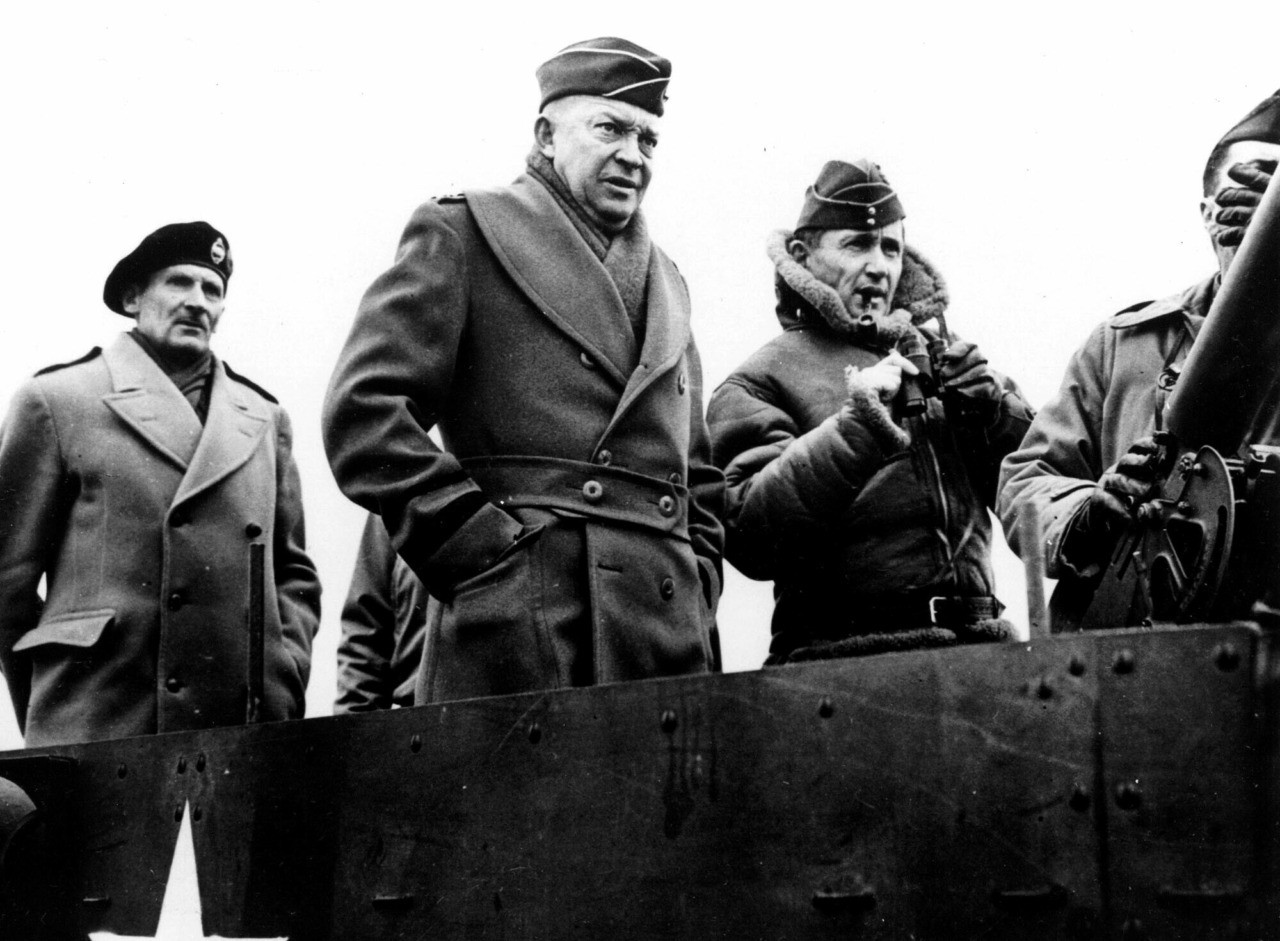
In March 1944, General Dwight D. Eisenhower, center, as Commander of the invasion of Europe. At center right is British Air Chief Marshal Sir Arthur W. Tedder and left is British Field Marshal Bernard Montgomery. (AP Photo, File)
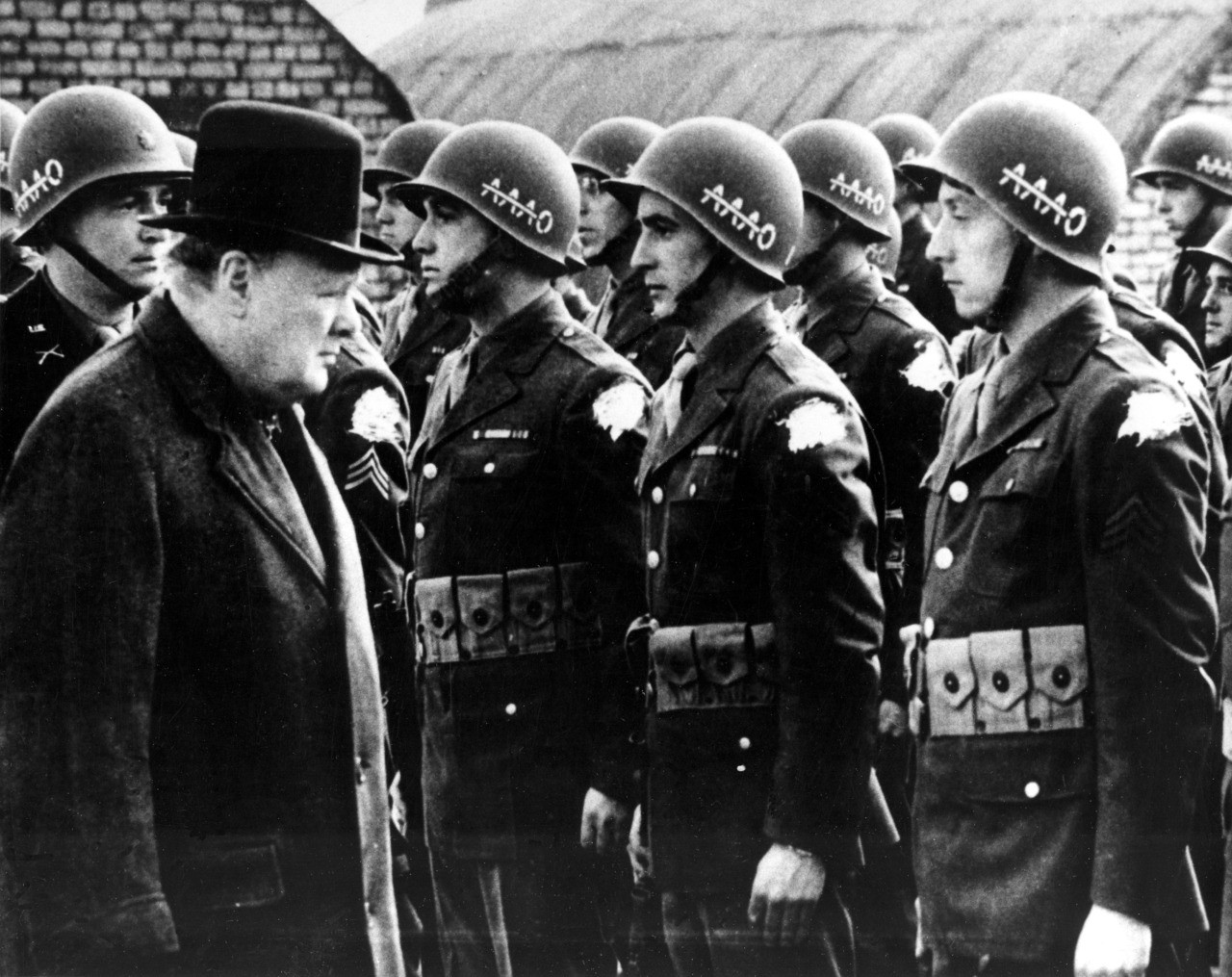
British Prime Minister Winston Churchill, left, reviews American troops at a base in England on the eve of D-Day, June 1944, during World War II. The initials AAAO on the steel helmets with a line across the As stands for “Anywhere, Anytime, Anyhow, Bar Nothing.” The identification shoulder patches of the G.I.s are blotted out by the censor. (AP Photo)

6th June 1944: Members of an American armoured unit seen here being lined up for a briefing from their commanding officer prior to receiving their D-Day assignments. (Photo by Keystone/Getty Images)
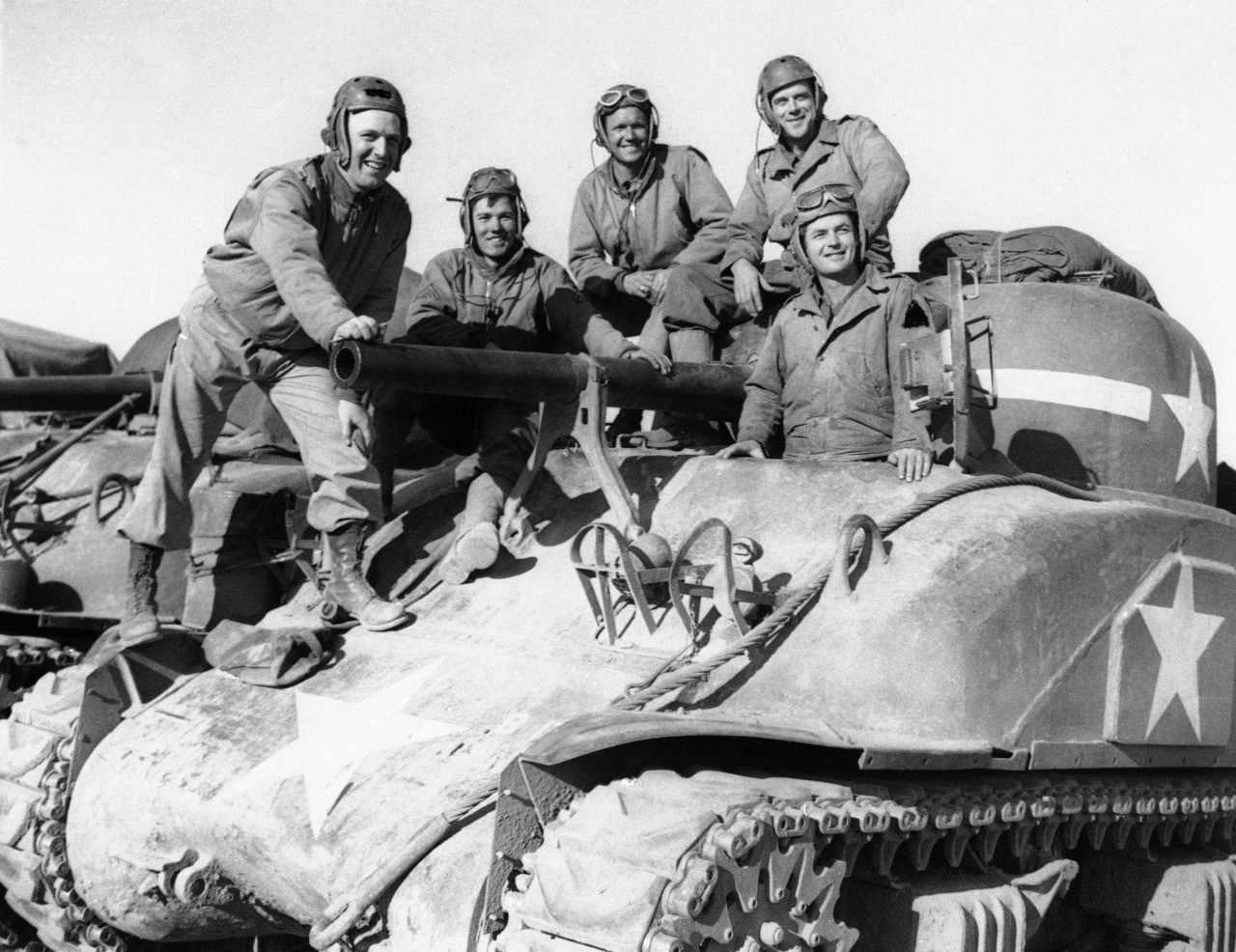
With a U.S. tank unit in England getting ready for D-Day in 1944, left to right are: Captain Leonard Brusky, Milwaukee, Wisconsin, Sergeant Wilfred F. Thomas, Wisconsin, Sergeant Frank L. Niner, Louisville, Kentucky, Pfc Harry H. Smith, Louisville, Kentucky, and Private Louis W. Louisville Kentucky. (AP Photo)
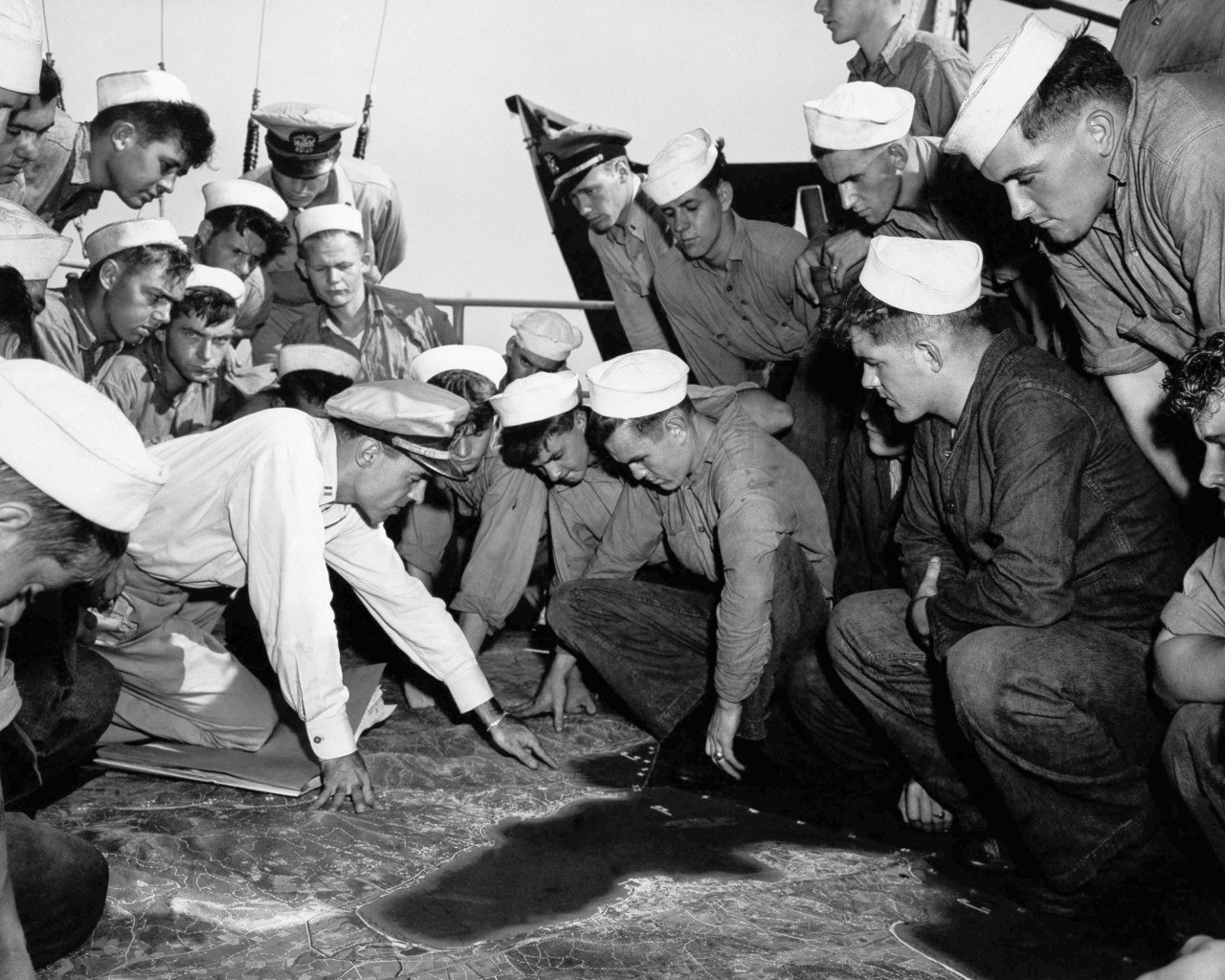
Lieutenant Harrie W. James, USNR, of New York, N.Y., briefs officers and men who participated in landing operations during the invasion of Southern France June 5, 1944 on the day before D-Day. (AP Photo)
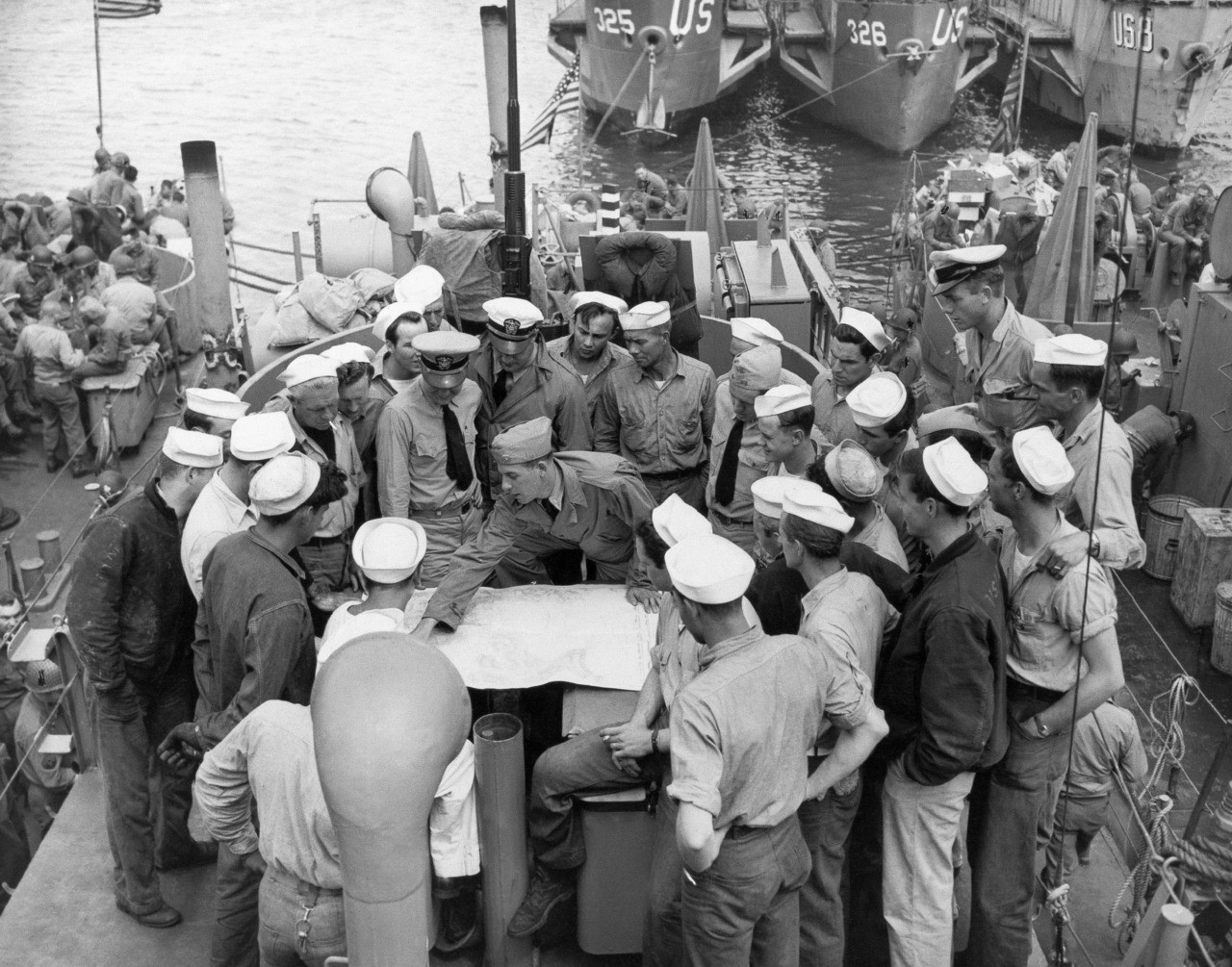
Lt. William V. Patten, centre of group, wearing overseas cap, briefs his crew at a port in England before the invasion of France began June 6, 1944. Patten and his ship are veterans of Tunisia, Salerno, Anzio and Licata. (AP Photo)

6th June 1944: Allied commander in chief General Dwight D. Eisenhower (1890 – 1969) talks to paratroopers of the 101st Airborne Division about to take off for the D-Day landings in France. (Photo by MPI/Getty Images)

6th June 1944: General Dwight D. Eisenhower (1890-1969) smiles while speaking with the men of the US 101st Airborne Division, ‘The Screaming Eagles’, as they prepare for the D-Day invasion, England, World War II. (Photo by Hulton Archive/Getty Images)
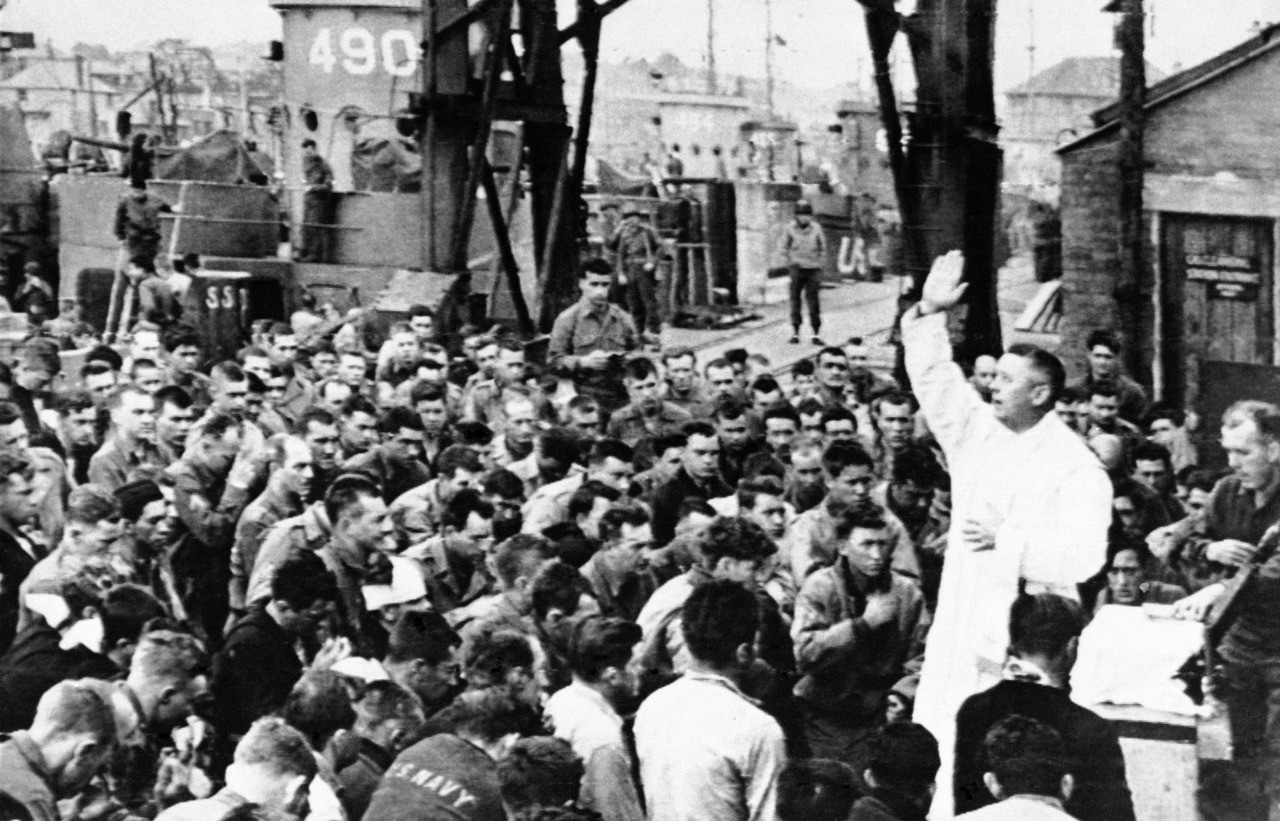
These members of the first groups of assault troops to take part in the Allied invasion of Northern France receive benediction from an Army chaplain before leaving England on June 6, 1944, for the European continent. Their assault craft are in the background. (AP Photo)
The following is the audio of General Eisenhower’s broadcast to the Allied troops on the eve of the battle:
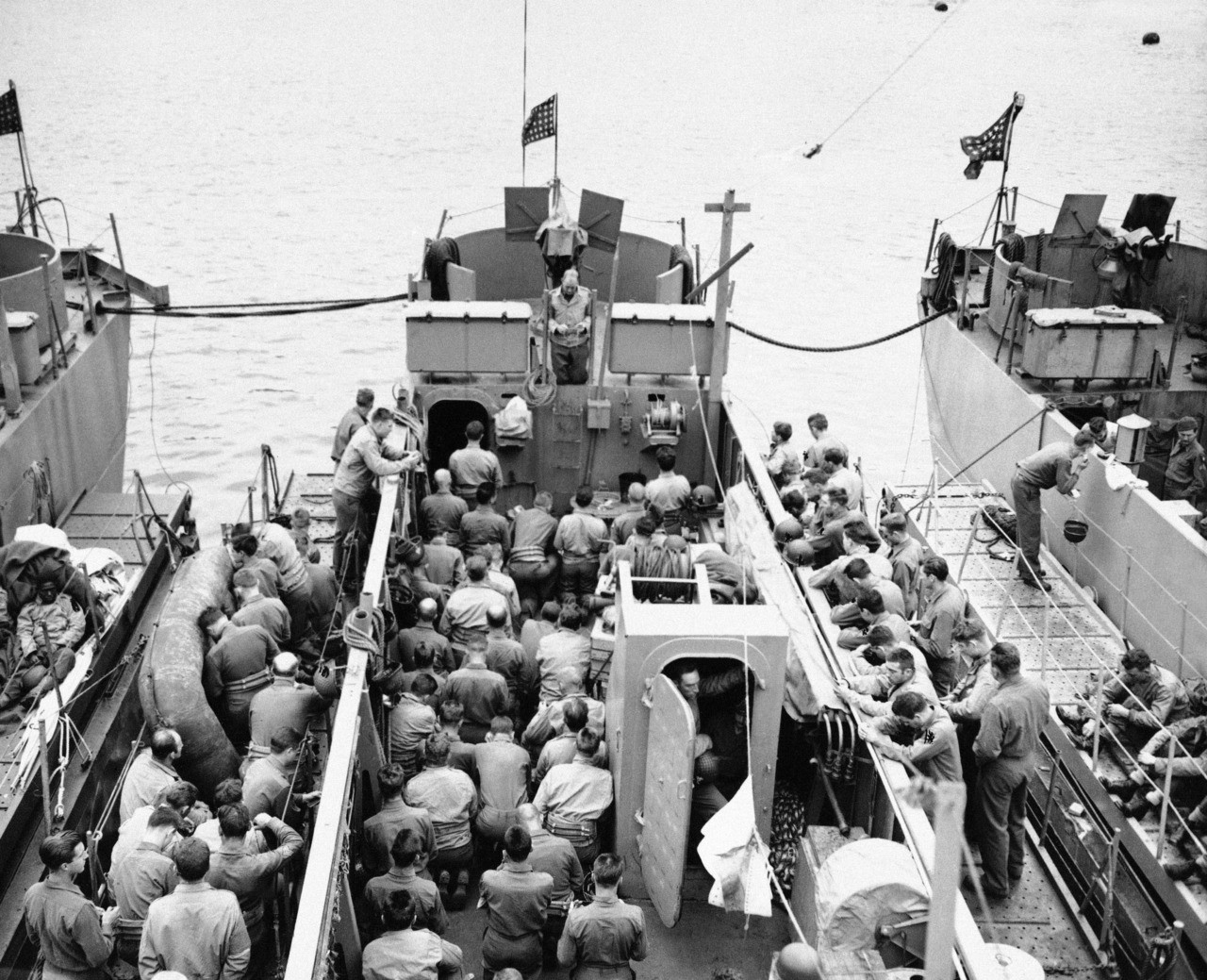
2nd Lt. Ray A. Karcy, of 31 Haddon Ave., Atlantic City, N.J., Army chaplain, conducts a Catholic service aboard a landing craft in an English port before the Americans set off for the invasion of Northern France. (AP Photo)
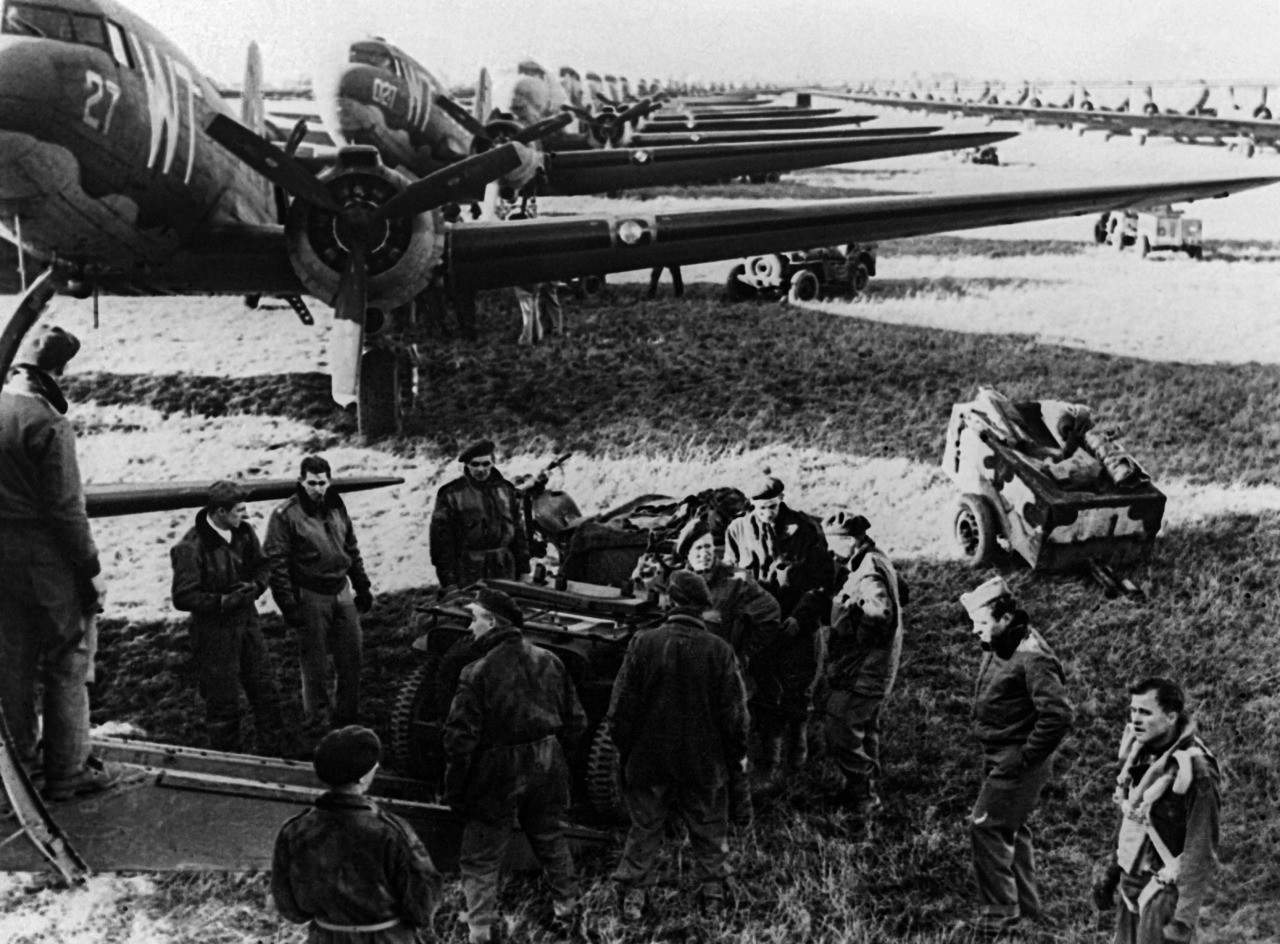
Allied aircrews work around C-47 transport planes at an unidentified English base in this photo taken shortly before the D-Day landings in Normandy, France. The C-47’s dropped parachutists from the US 82nd and 101st Airborne Divisions behind Utah Beach near Saint-Mere-Eglise 06 June 1944, during the first hours of Operation Overlord. (AFP/Getty Images)
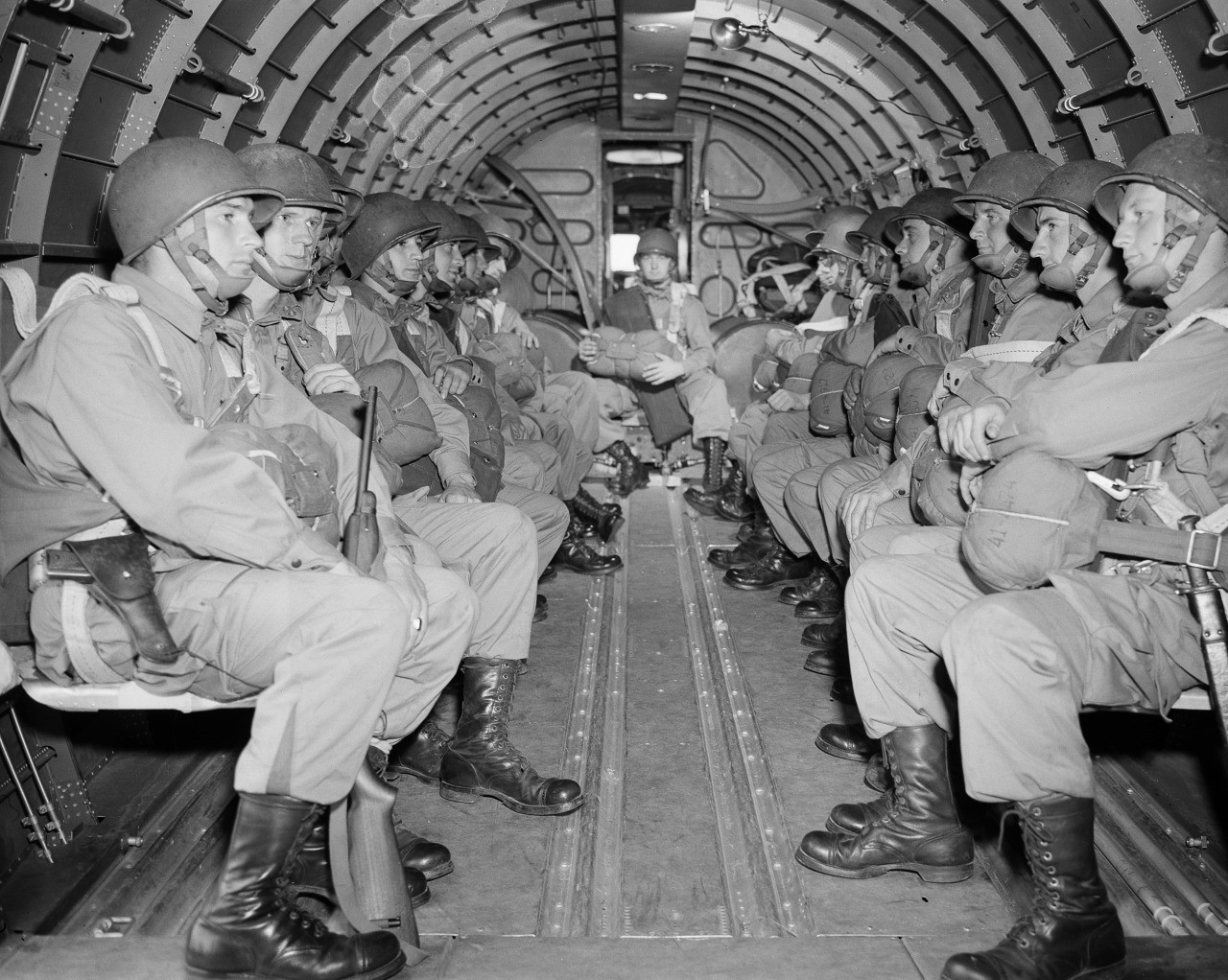
American paratroopers, heavily armed, sit inside a military plane as they soar over the English Channel en route to the Normandy French coast for the Allied D-Day invasion of the German stronghold during World War II, June 6, 1944. (AP Photo)
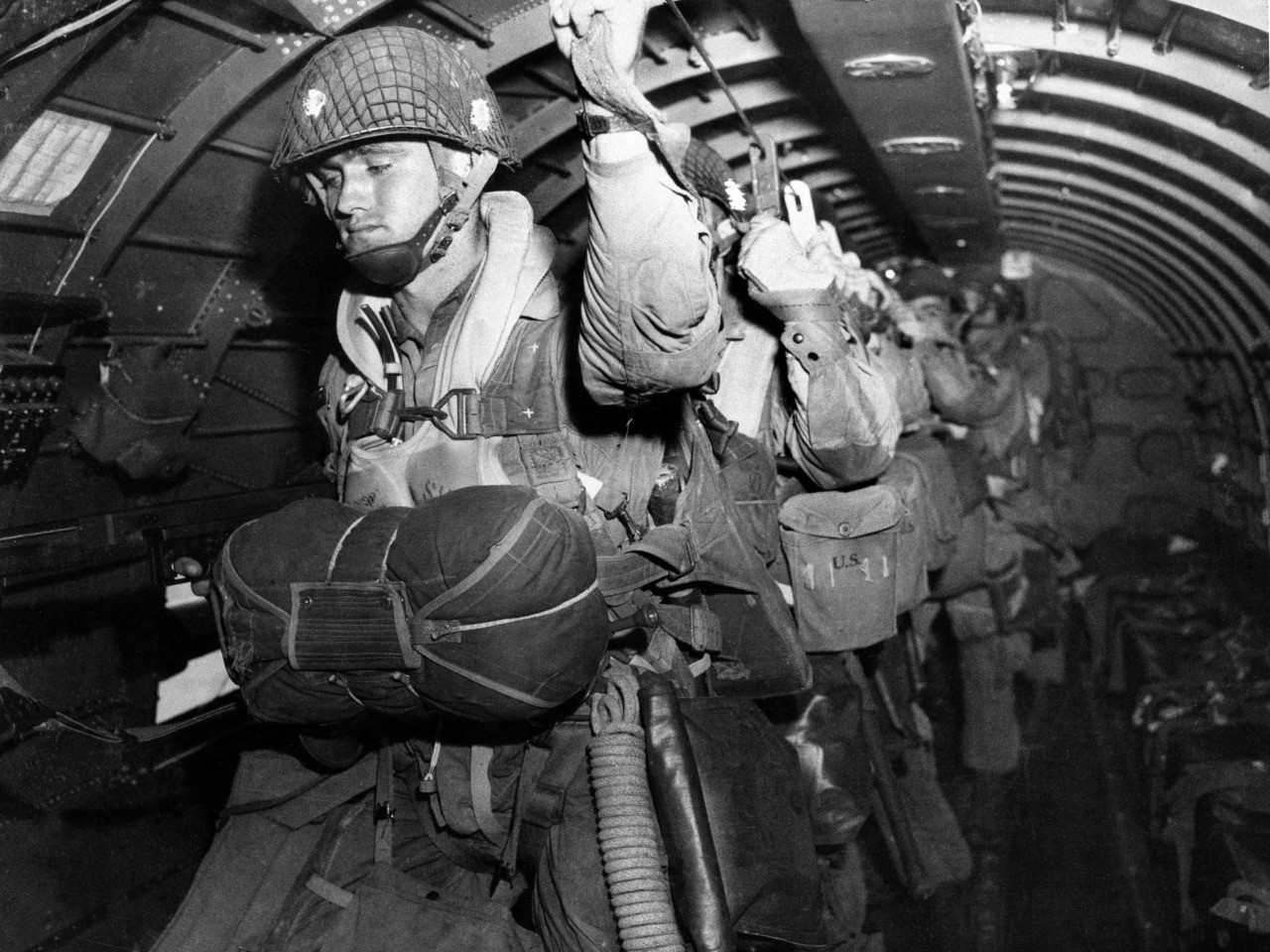
In this photo provided by the U.S. Army Signal Corps, U.S. paratroopers fix their static lines before a jump before dawn over Normandy on D-Day June 6, 1944, in France. The decision to launch the airborne attack in darkness instead of waiting for first light was probably one of the few Allied missteps on June 6, and there was much to criticize both in the training and equipment given to paratroopers and glider-borne troops of the 82nd and 101st airborne divisions. Improvements were called for after the invasion; the hard-won knowledge would be used to advantage later. (AP Photo/U.S. Army Signal Corps)
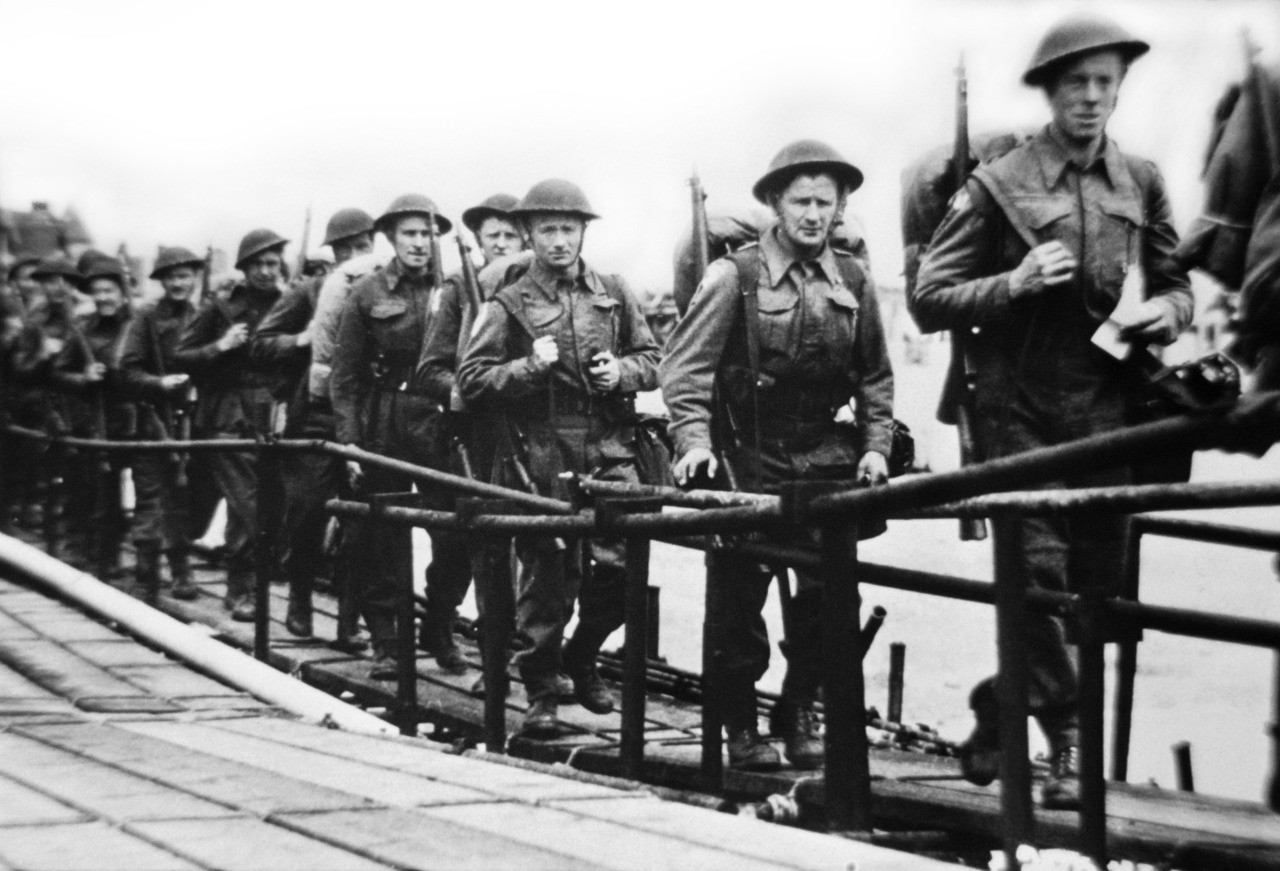
Picture released on June 5, 1944 of the British troops embarking at Southsea, Portsmouth in England, before a landing craft on June 6, 1944 while Allied forces storm the Normandy beaches on D-Day. (AFP/Getty Images)

6th June 1944: US Army troops seen marching through the streets of an embarkation port on the coast of England on their way over to Normandy, France. (Keystone/Hulton Archive/Getty Images)
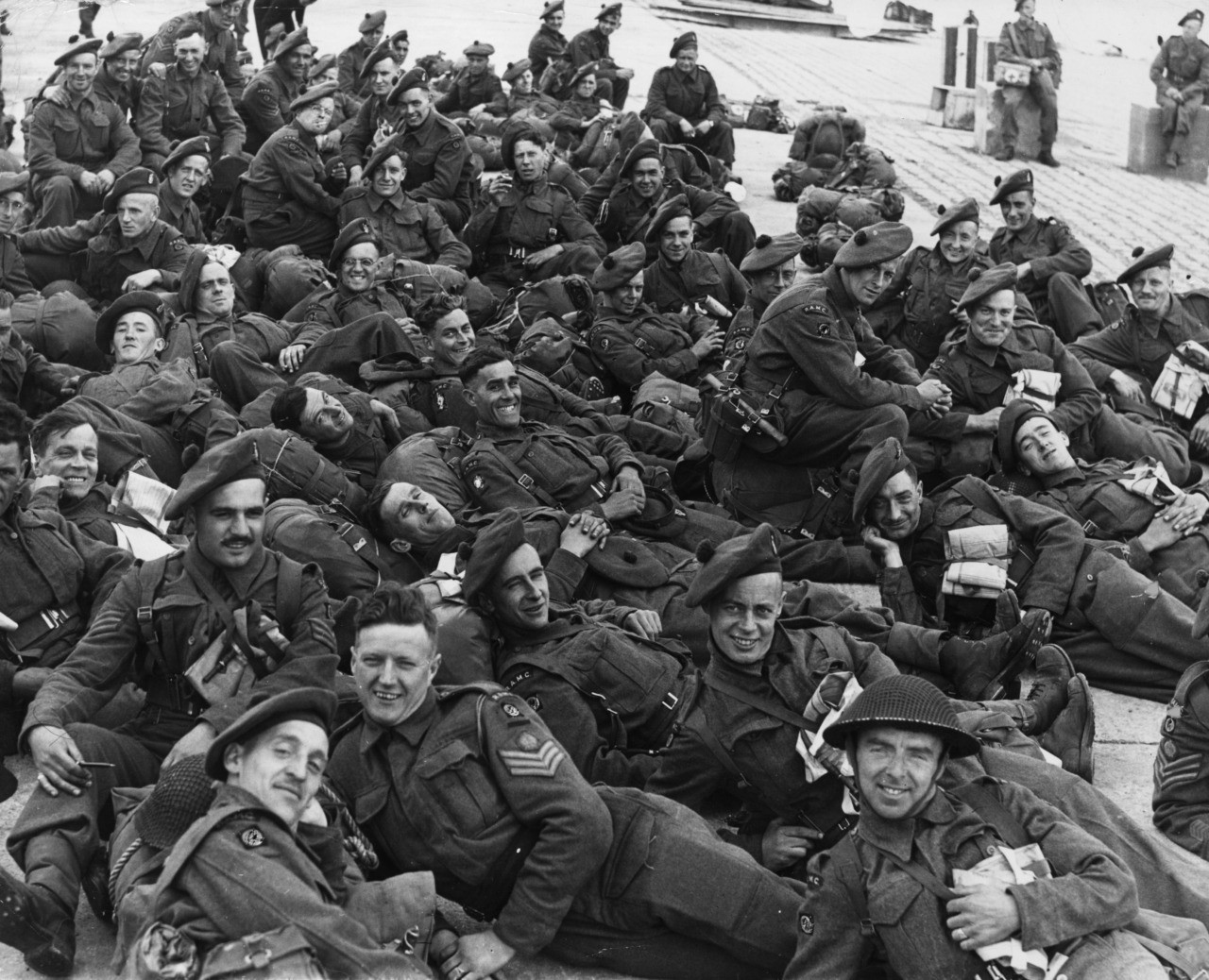
British soldiers of the RAMC (Royal Army Medical Corps) during the Normandy Landings, June 1944. (Keystone/Hulton Archive/Getty Images)

Armored vehicles arriving at a British Port for transportation to France on June 6, 1944. (AP Photo)

As the Allied invasion of the Normandy gets underway, American troops are shown as they embark in landing crafts at a British port, on June 6, 1944. (AP Photo/Peter Carroll)

6th June 1944: US soldiers in full battle-dress boarding an LCVP or Landing Craft Vehicle-Personnel, ready for the Invasion of Europe. (Photo by Keystone/Getty Images)
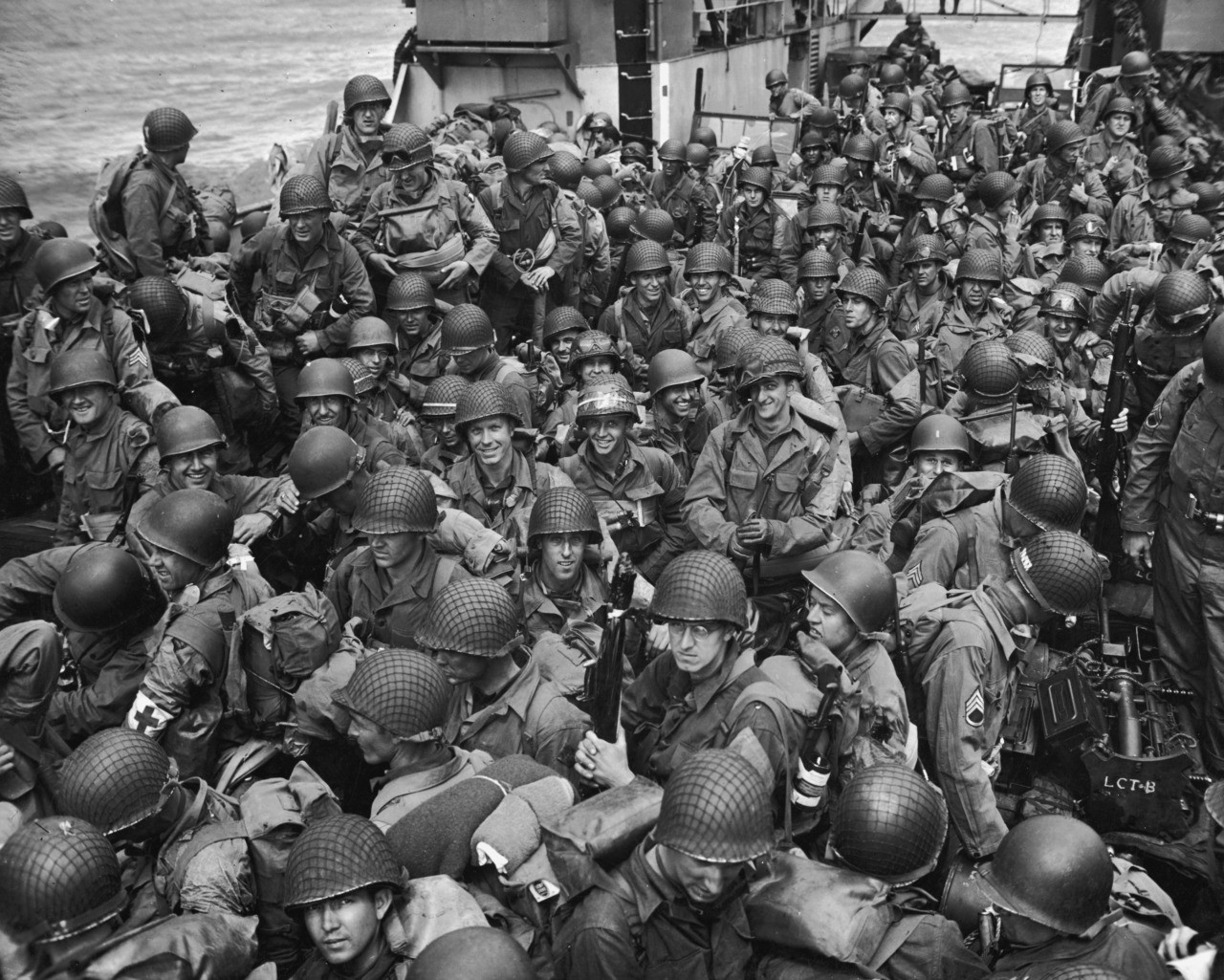
6th June 1944: US Army troops crowd into a navy landing craft infantry ship during the D-Day Invasion of Normandy, France, World War II. (Photo by US Navy/Getty Images)
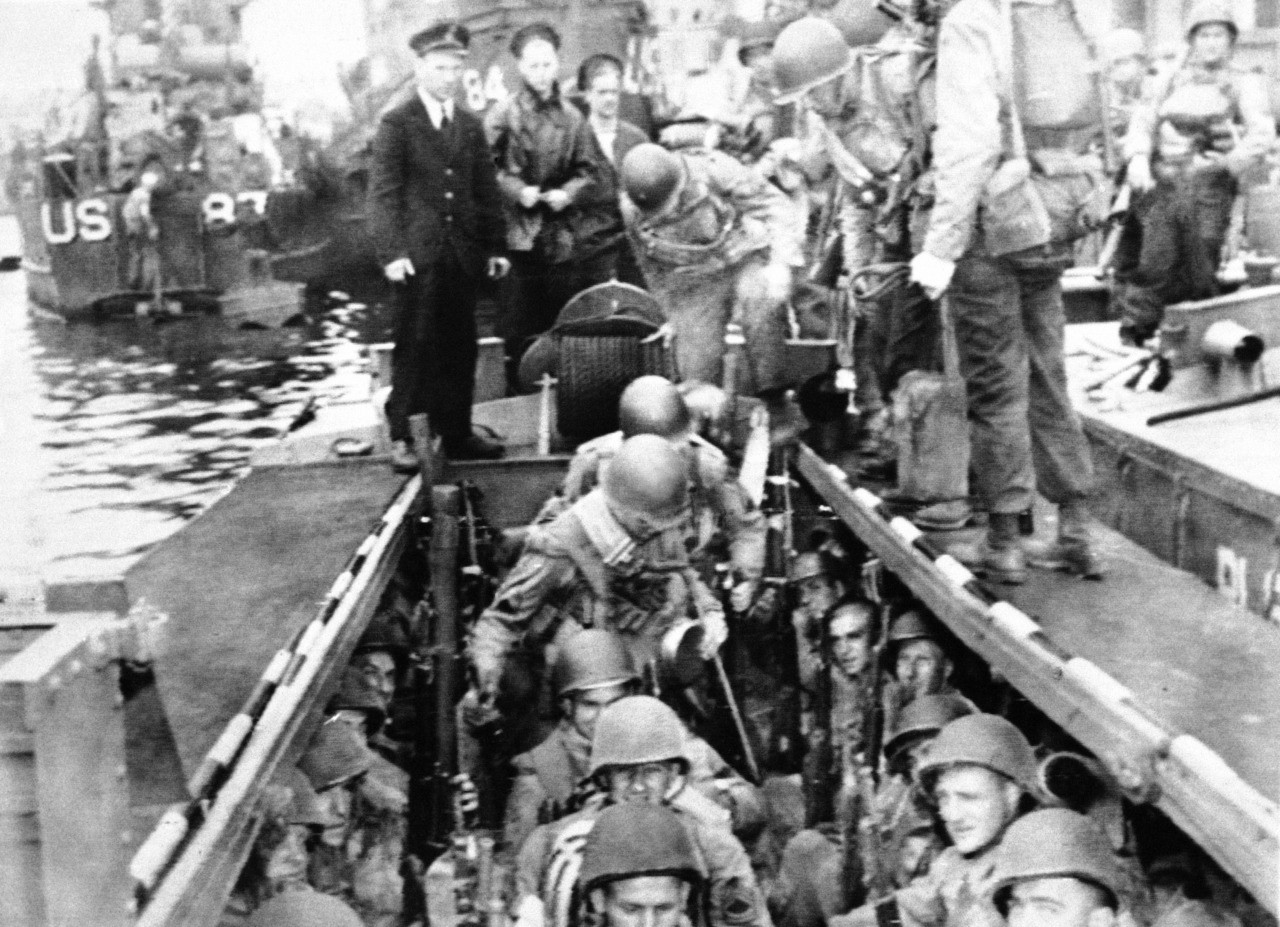
Fully equipped, and each carrying large amounts of ammunition, American troops climb aboard a landing craft somewhere in England on June 6, 1944 for the cross-channel invasion of France. Other landing craft are seeing in background. (AP Photo)

Bouncing about on the rough waters of the Channel, these landing craft loaded with assault troops head for the shore of the French coast early in the dawn of D-Day, June 6, 1944. In the surprise invasion attack, the allies suffered a minimum loss and have succeeded in cutting a 29-mile wedge in the Cherbourg Penninsula. (AP Photo)
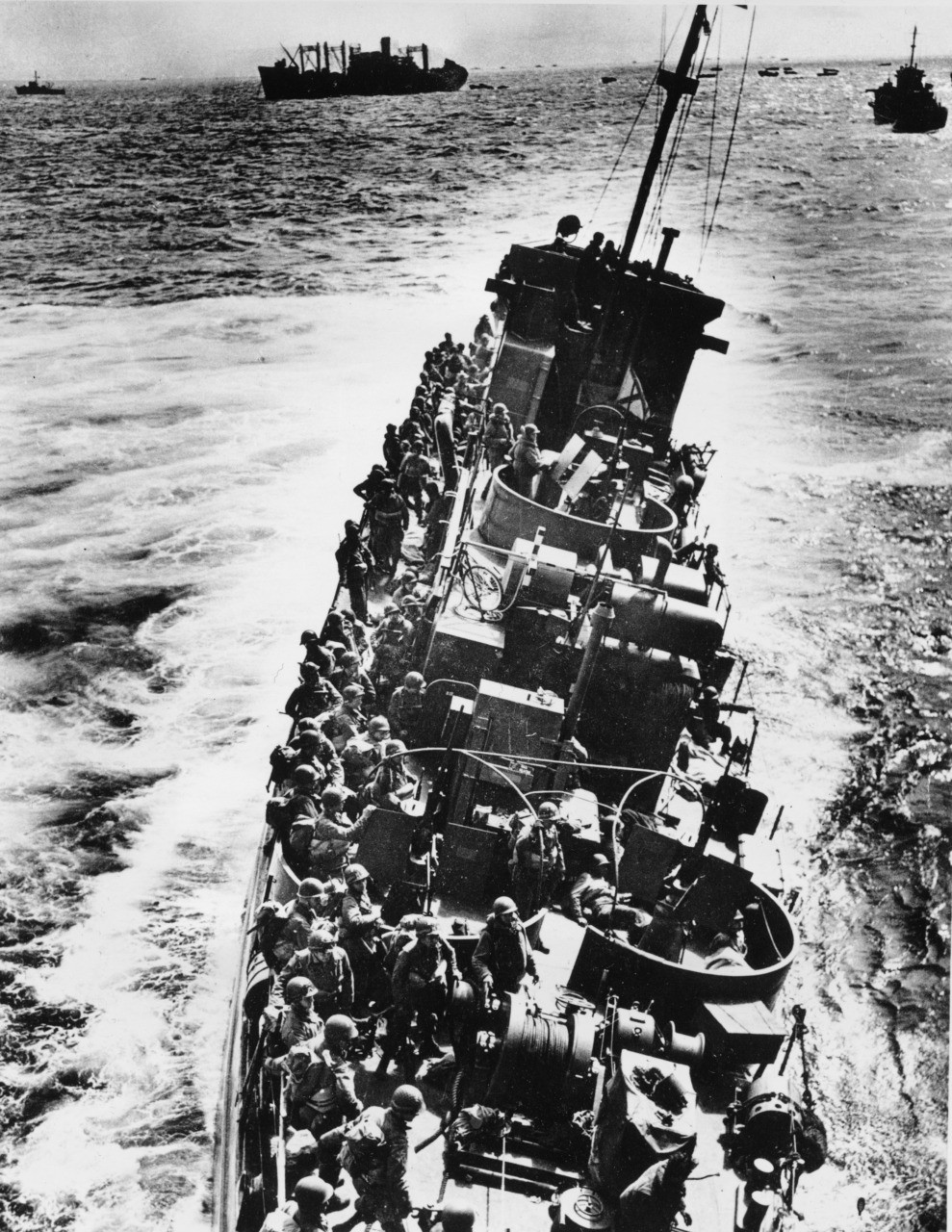
A U.S. Coast Guard LCI, heavily listing to port, moves alongside a transport ship to evacuate her troops, during the initial Normandy landing operations in France, on June 6, 1944. Moments later the craft will capsize and sink. Note that helmeted infantrymen, with full packs, are all standing to starboard side of the ship. (AP Photo)
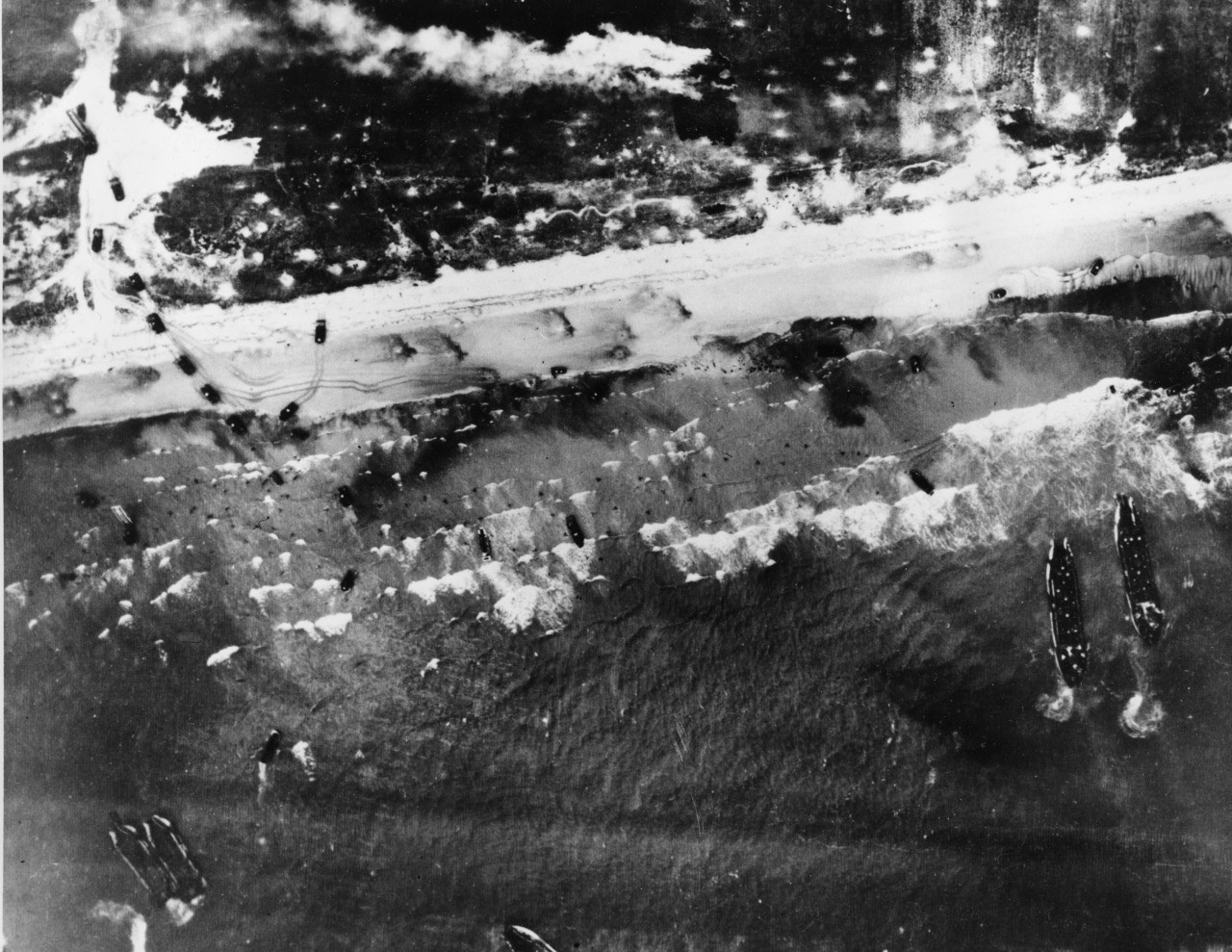
Men and assault vehicles storm the beach as Allied landing craft reach their destination during the initial Normandy landing operations in France, on June 6, 1944. (AP Photo)
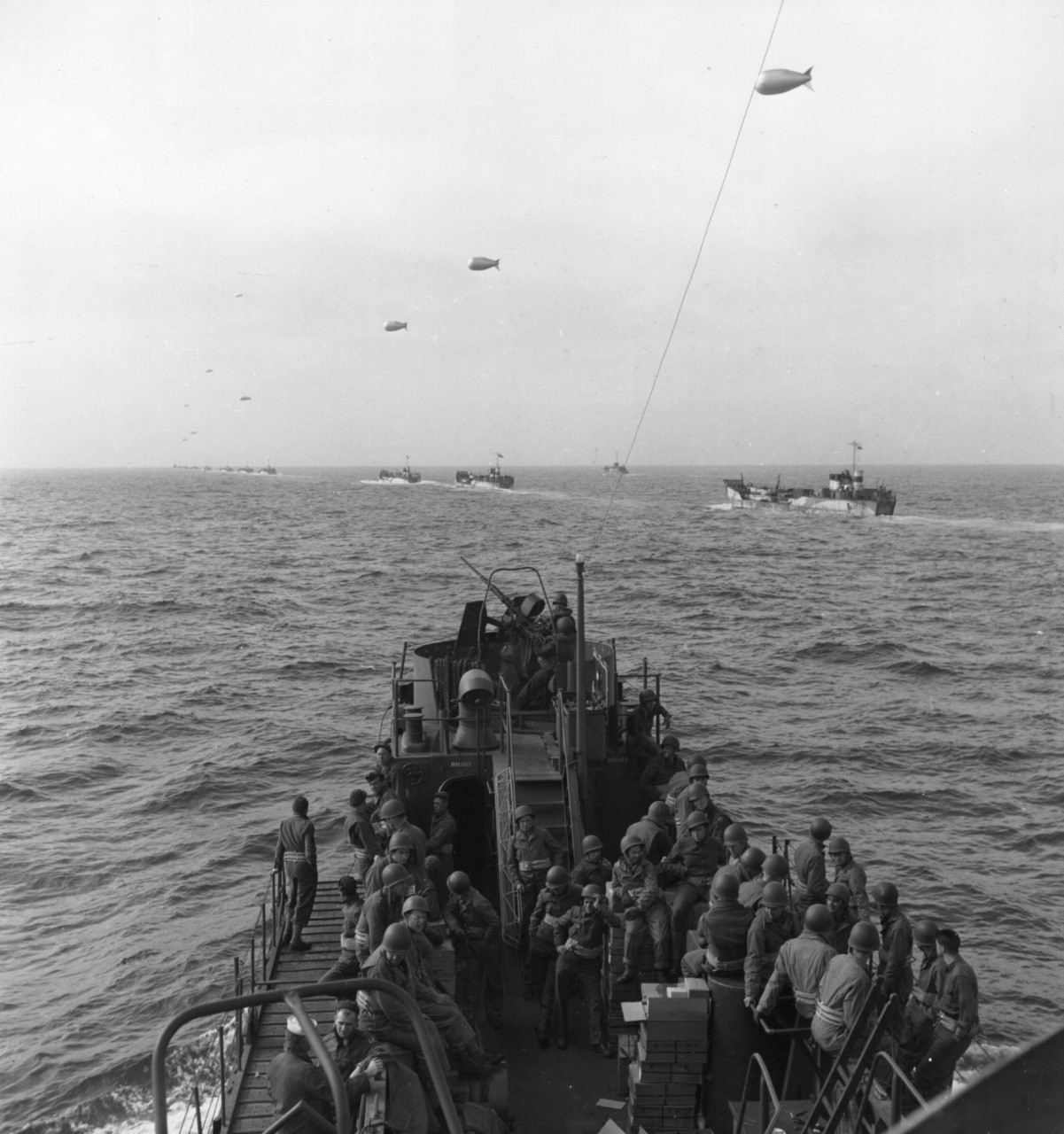
June 1944: Members of the 9th Air Force watch a long line of landing craft carrying barrage balloons, on their way over to Normandy. (Photo by Keystone/Getty Images)

A convoy of Allied landing craft, protected by barrage balloons, crosses the English Channel on its way to France during the Normandy Landings, World War II, 6th June 1944. The craft are carrying ground support personnel and equipment of the US 9th Air Force. (Photo by Keystone/Hulton Archive/Getty Images)

1944: A B-24 Liberator flying over the invasion Armada, heading towards the French coast. (Photo by Keystone/Getty Images)
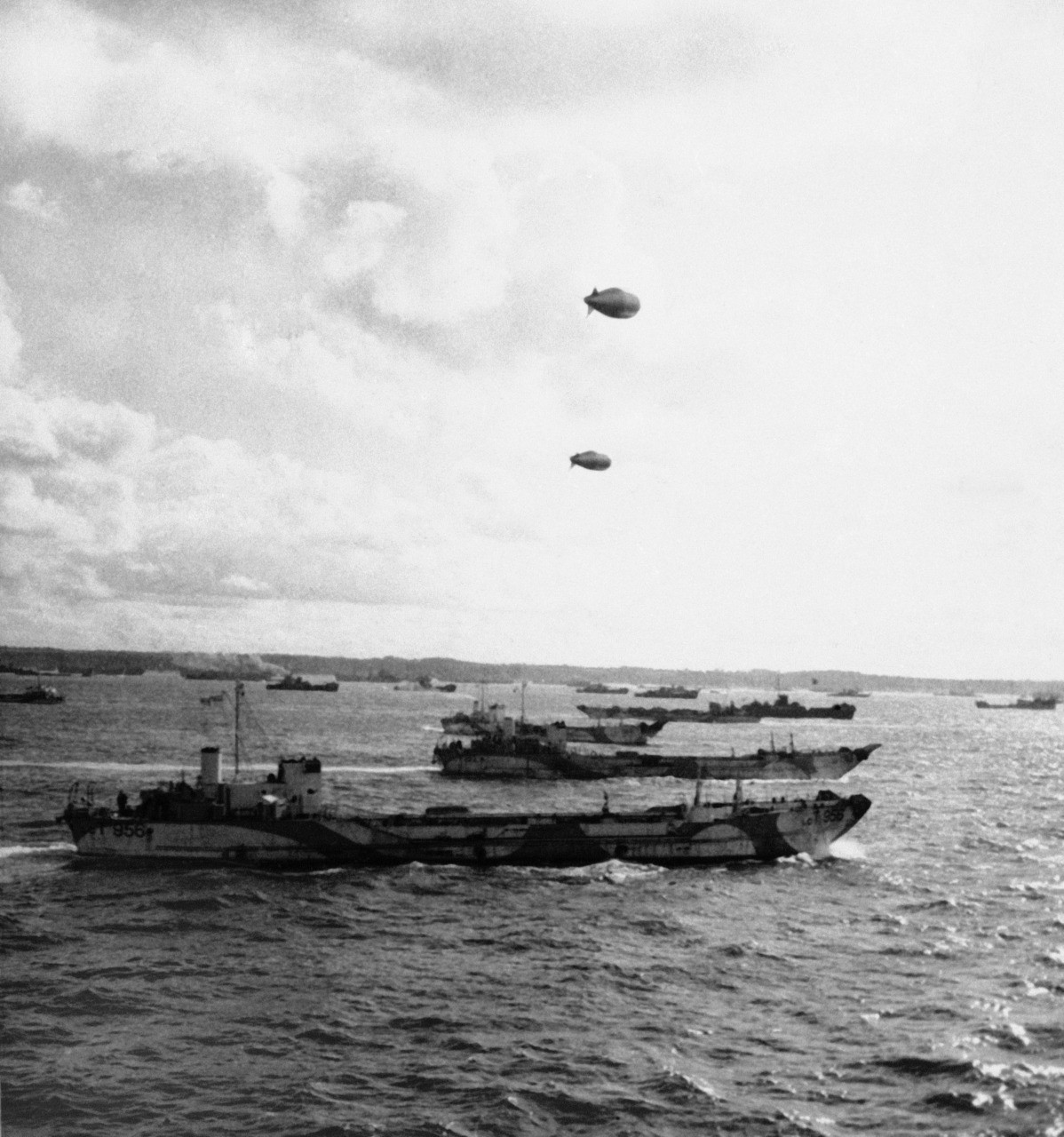
Destroyers and small naval craft patrol the Channel and protect ships carrying reinforcements in men and materials against the enemy in Normandy in June 1944. (AP Photo)
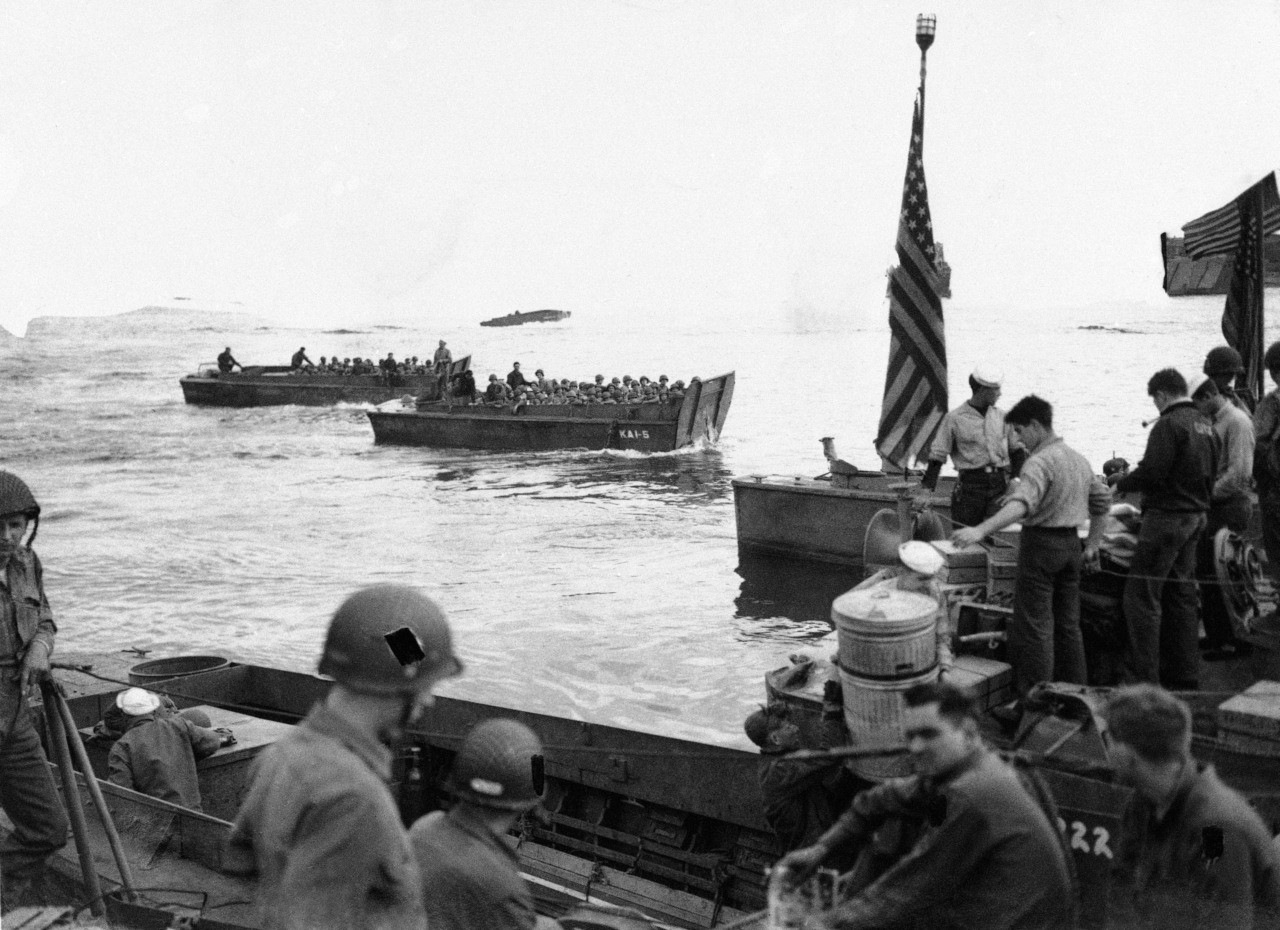
Landing craft loaded with American troops pass other landing craft lining the dock side while in foreground, other craft take on equipment on June 6, 1944. (AP Photo)

6th June 1944: In the distance American Infantrymen are wading towards the beach on the Northern Coast of France during the D-Day Landings. (Photo by Keystone/Getty Images)

American assault troops in a landing craft near a beachhead in northern France. The landing is supported by naval gunfire. (Photo by MPI/Getty Images)
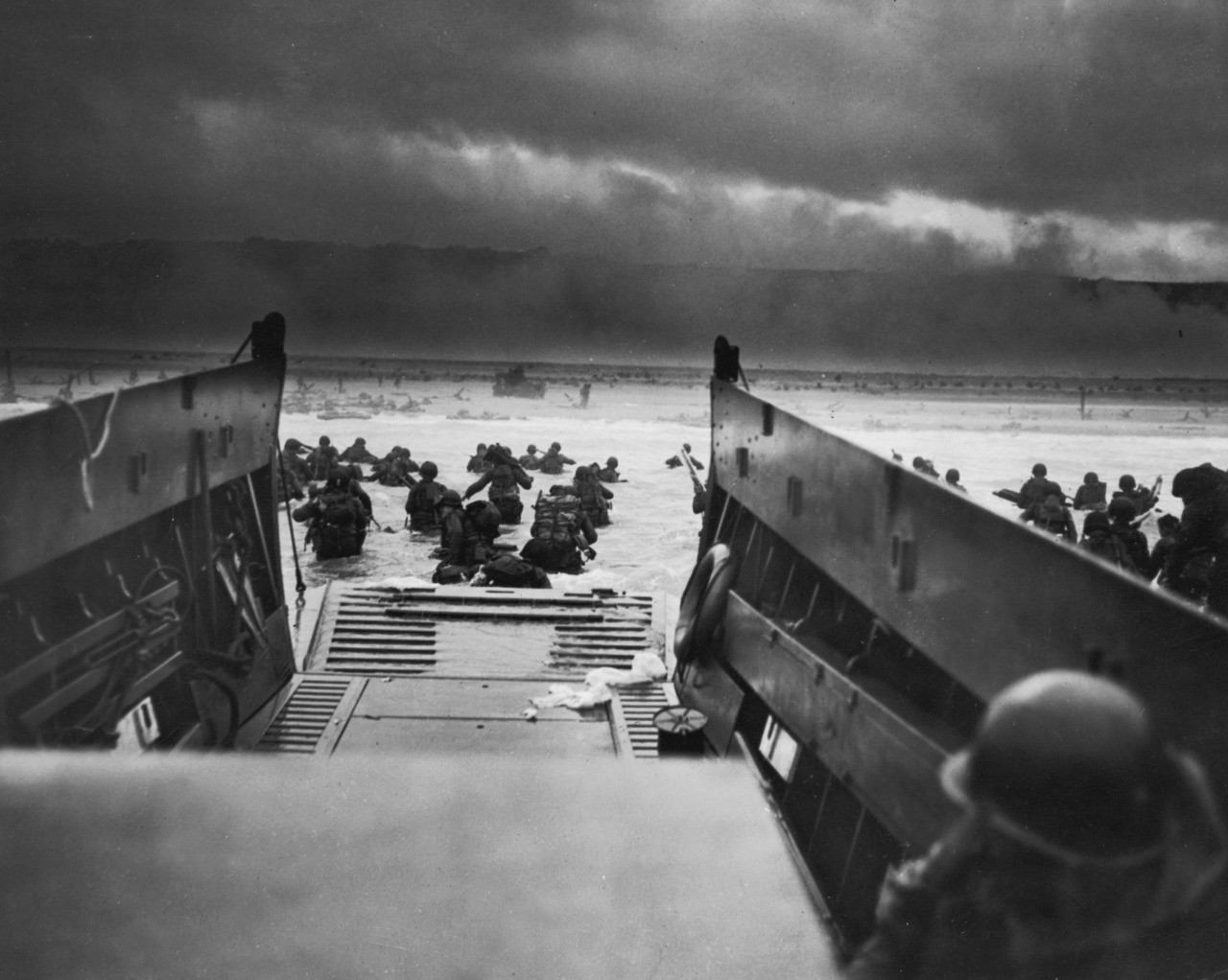
A view from inside one of the landing craft after US troops hit the water during the Allied D-Day invasion of Normandy, France. The US troops on the shore are lying flat under German machine gun resistance. (Photo by Robert F Sargent/Getty Images)
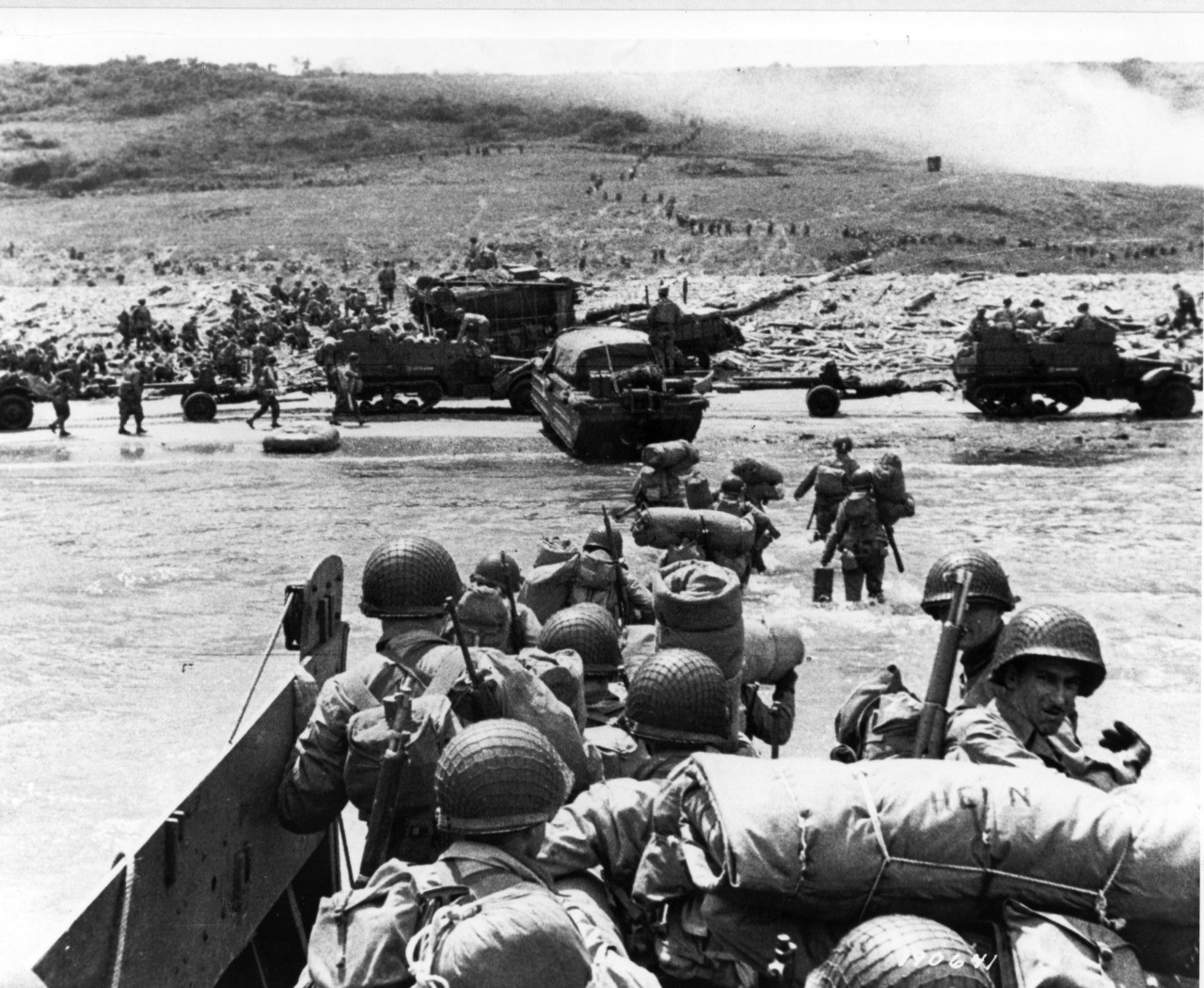
6th June 1944: American assault troops land at Omaha Beach in Normandy supported by Naval gunfire. (Photo by Wall/MPI/Getty Images)
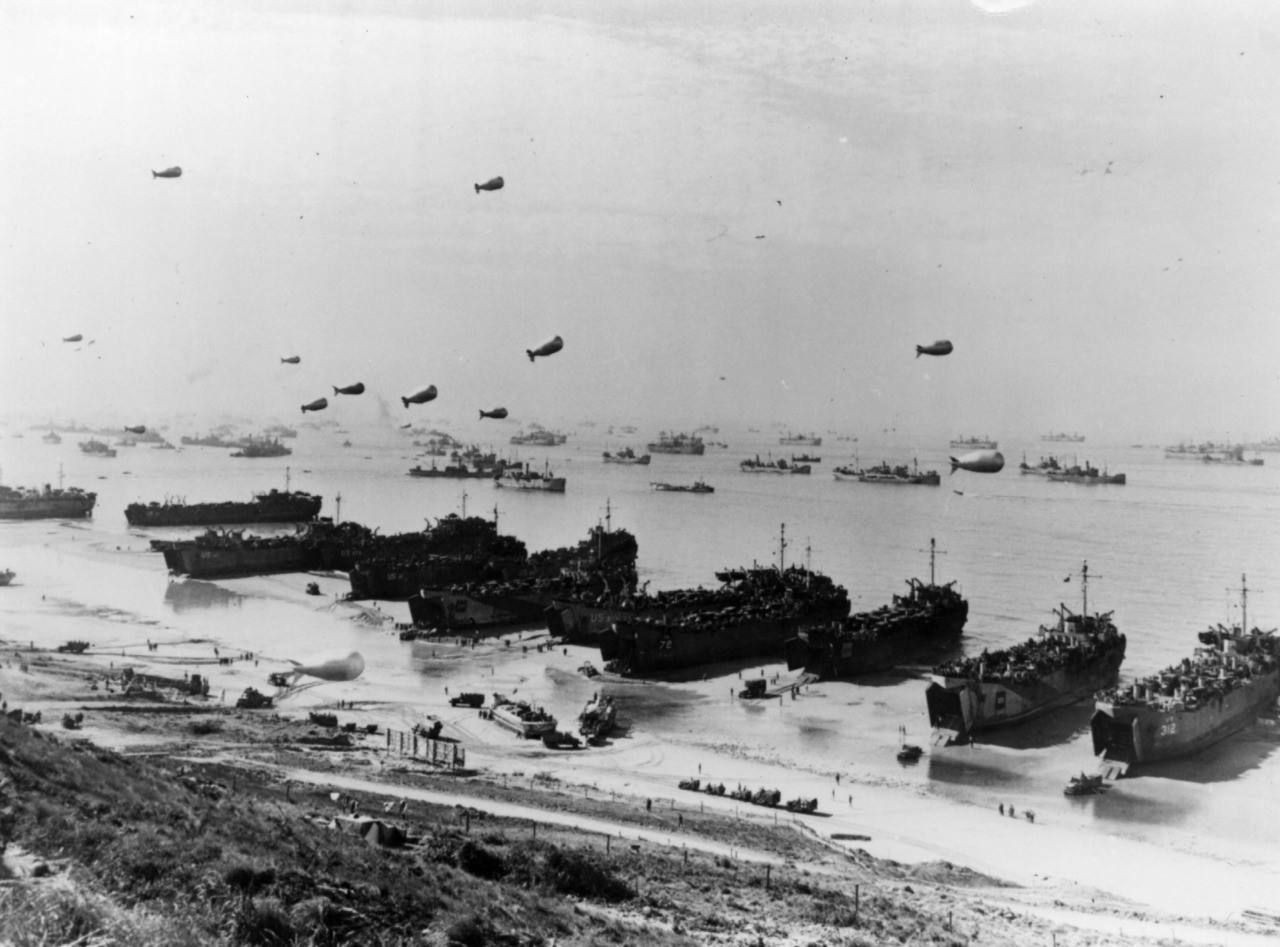
Barrage balloons and shipping at Omaha Beach during the Allied amphibious assault, before the installation of Mulberry Harbour. (Photo by Three Lions/Getty Images)

Canadian soldiers land on Courseulles beach in Normandy, 06 June 1944 as Allied forces storm the Normandy beaches on D-Day. (AFP/Getty Images)
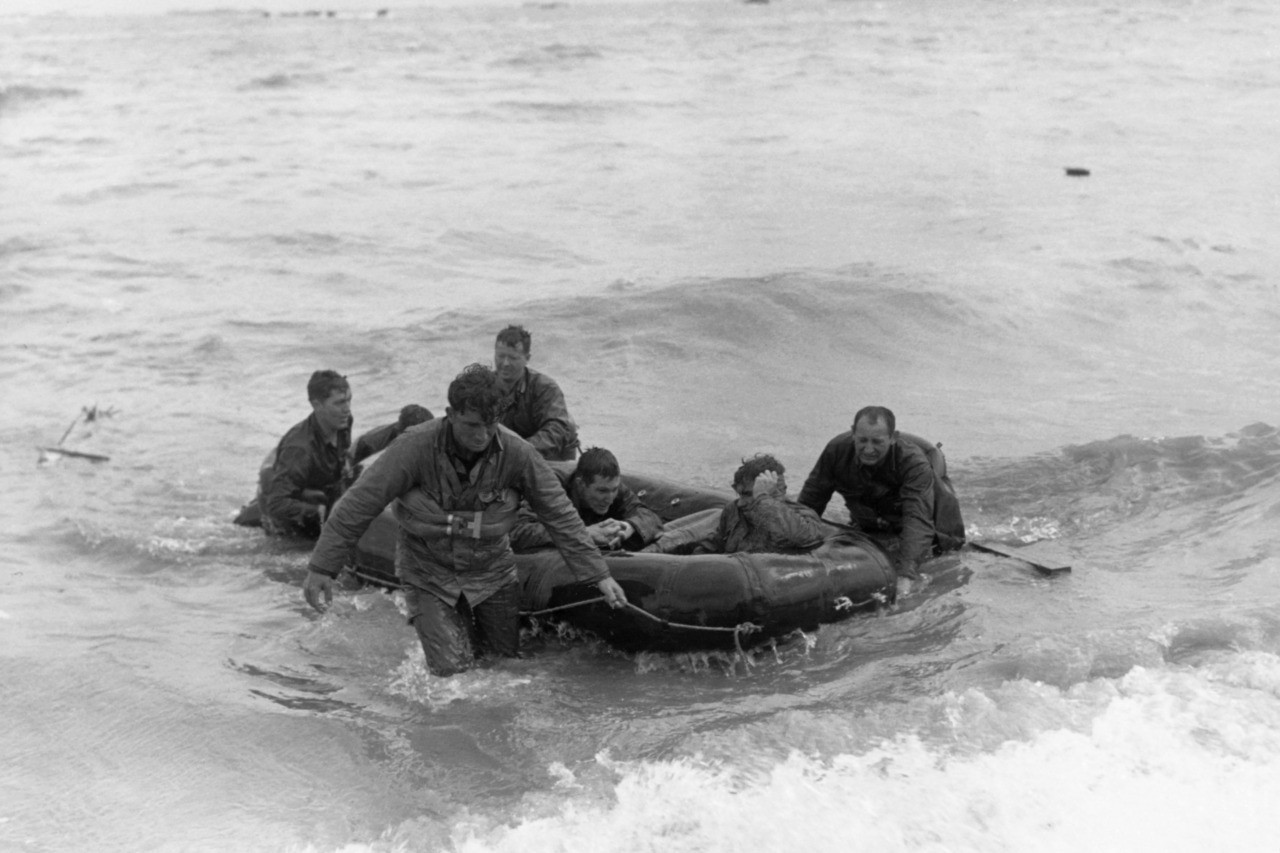
Survivors of a sunken LCVP (landing craft, vehicle, personnel, also known as a Higgins boat) arrive safely ashore in a rubber life raft at Omaha Beach on June 6, 1944 during the Normandy landing, France. (AFP/Getty Images)
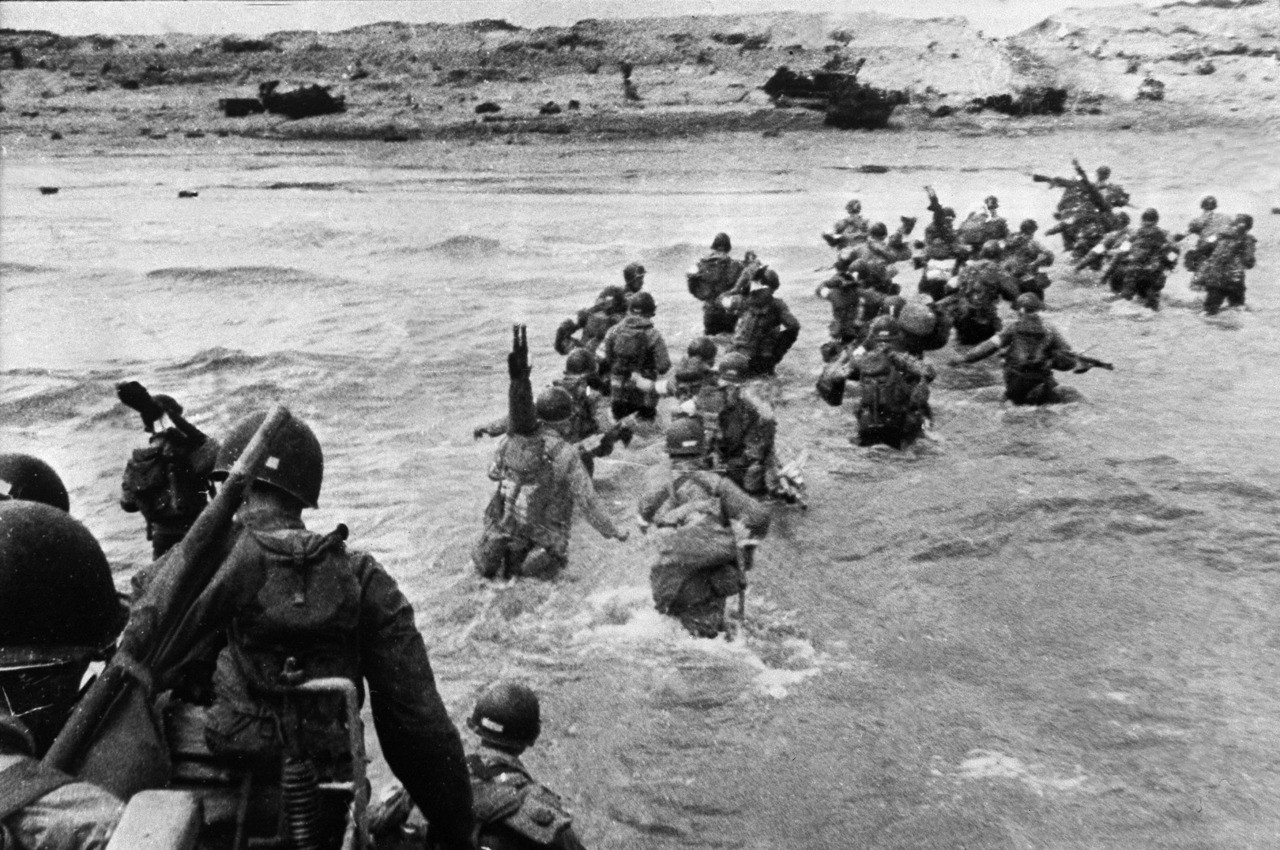
American troops landed on Normandy beaches (north-west of France), to come as reinforcements during the historic D-Day, 06 June 1944, during WW2. American troops supporting those already on the coast of Northern France, plunge into the surf and wade shoreward carrying equipment, on Utah Beach, Les Dunes de Madeleine, France. Bulldozers and other engineer equipment prepare the beach for the landing parties. (STF/AFP/Getty Images)

6th June 1944: Injured members of an American landing party whose landing craft was sunk off the coast of France reach Utah Beach near Cherbourg on a life-raft. (Photo by Weintraub/MPI/Getty Images)
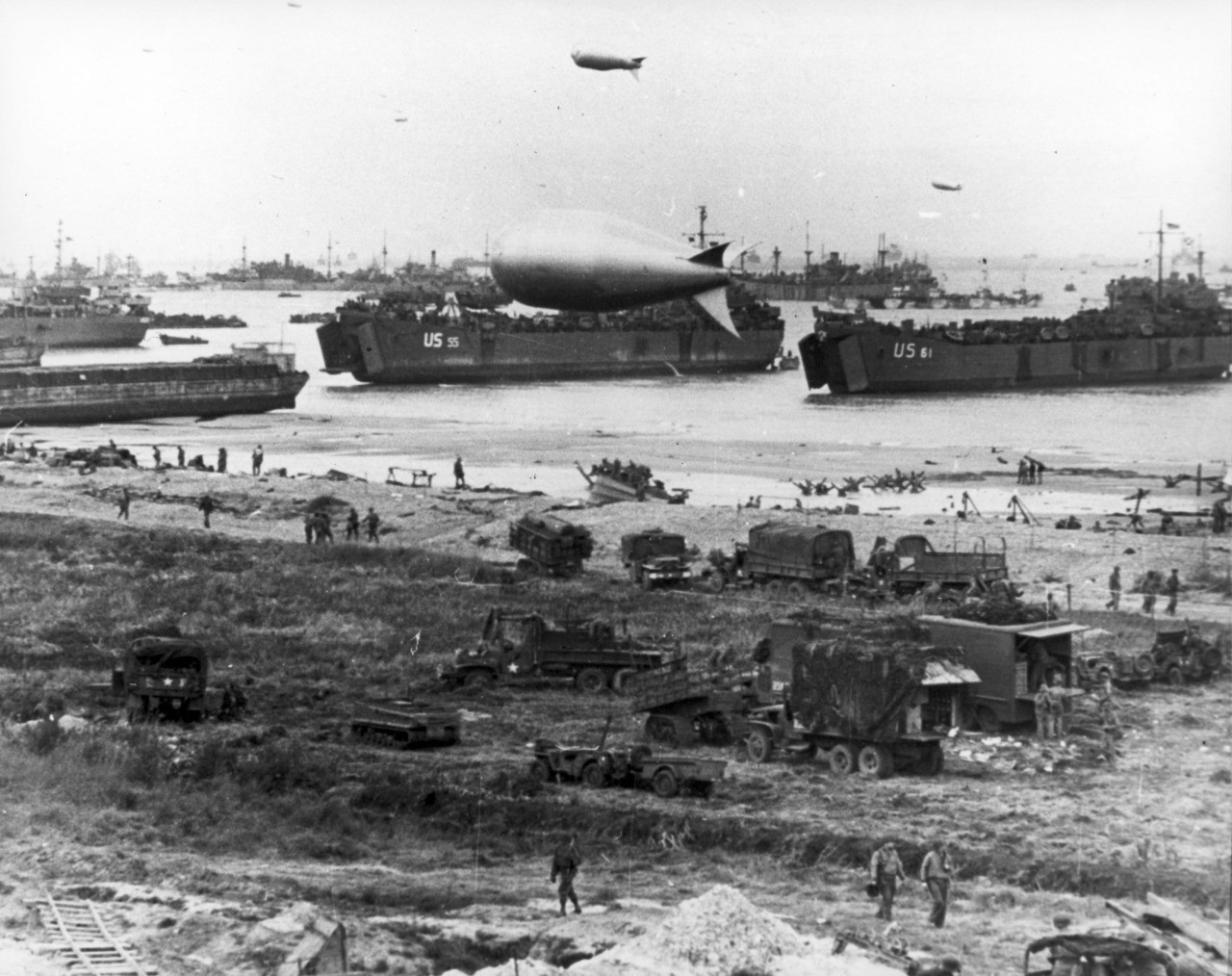
6th June 1944: Allied soldiers, tanks and ships take part in the D-Day landings at Arromanches beach in Normandy, Northern France. (Photo by Steck/MPI/Getty Images)
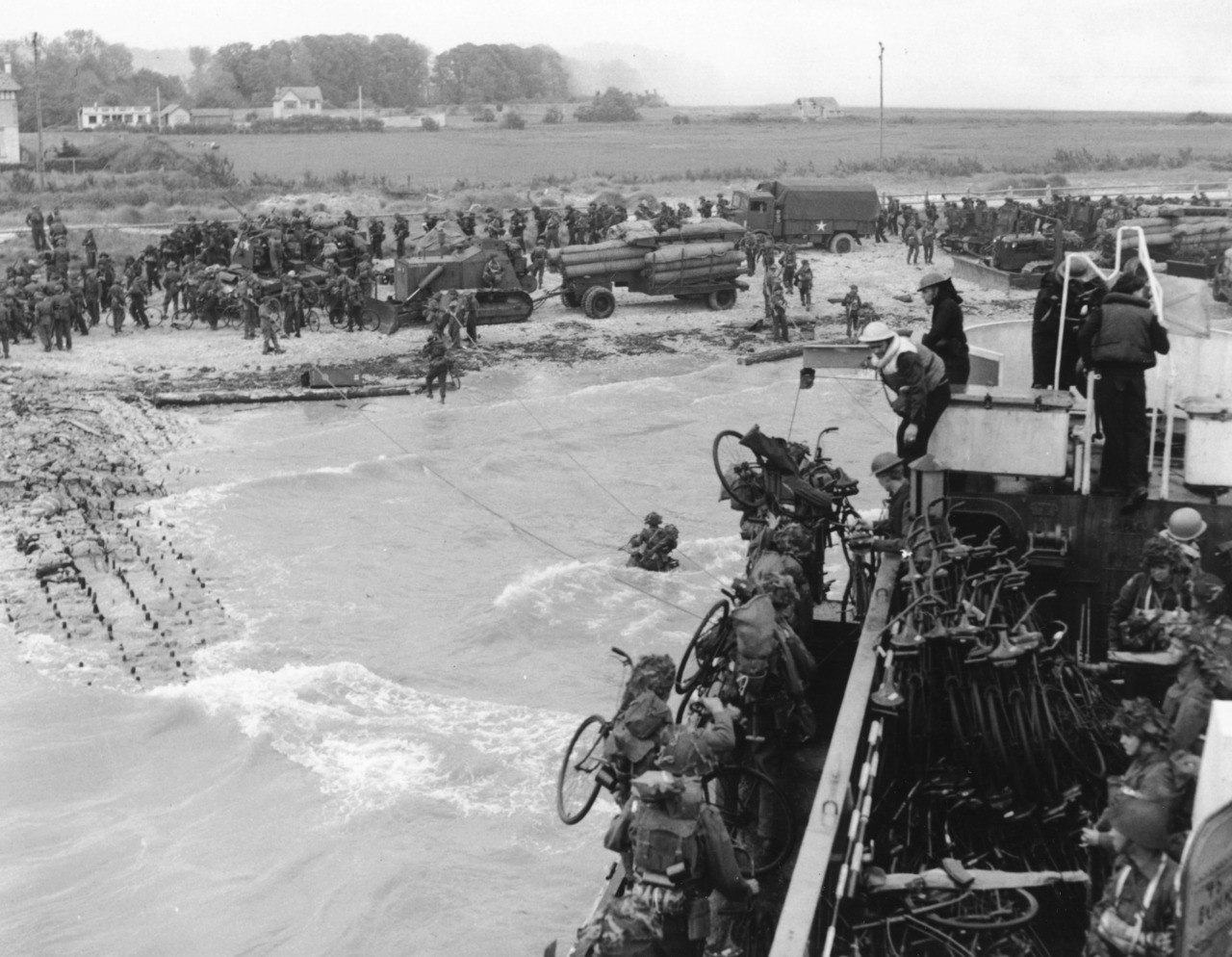
Soldiers of the 2nd Canadian Flotilla are seen as they establish a beachhead code-named Juno Beach, near Bernieres-sur-mer, on the northern coast of France, on June 6, 1944, during the Allied invasion of the Normandy. (AP Photo)
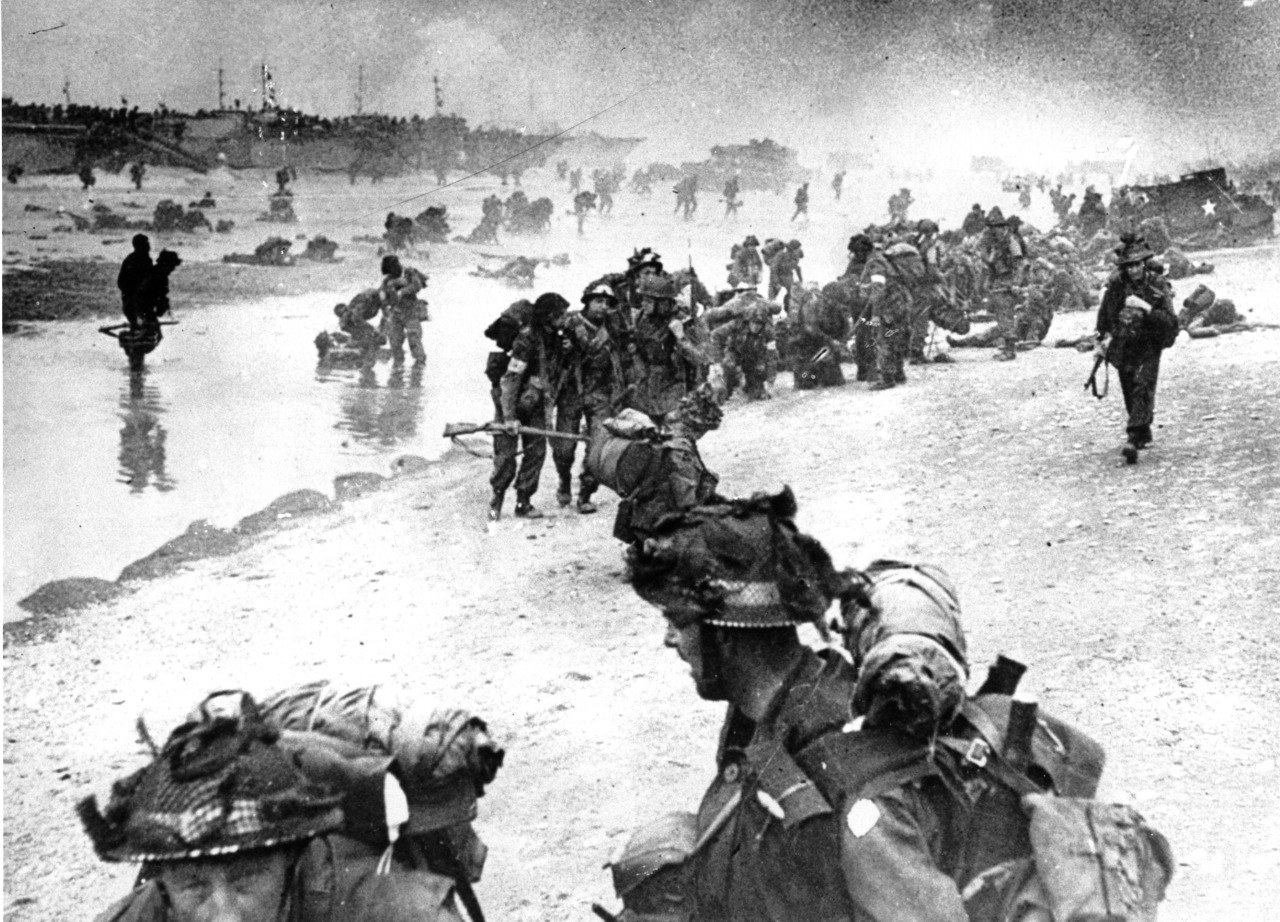
In this photo provided by the British Navy, wounded British troops from the South Lancashire and Middlesex regiments are being helped ashore at Sword Beach, June 6, 1944, during the D-Day invasion of German occupied France during World War II. (AP Photo/British Navy)
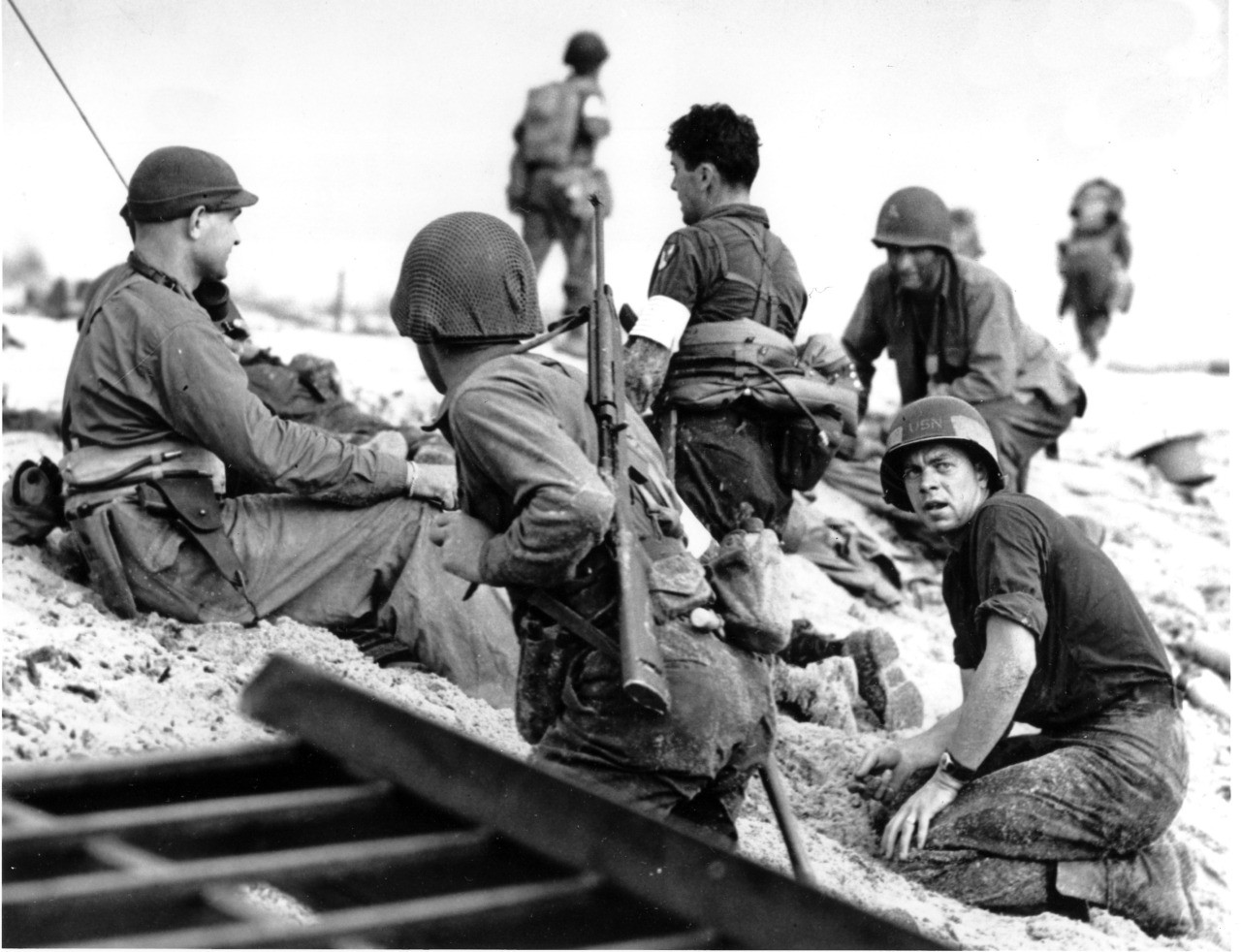
A first wave beach battalion Ducks lays low under the fire of Nazi guns on the beach of southern France on D-Day, June 6, 1944 during World War II. One invader operates a walkie talkie radio directing other landing craft to the safest spots for unloading their parties of fighting men. (AP Photo)
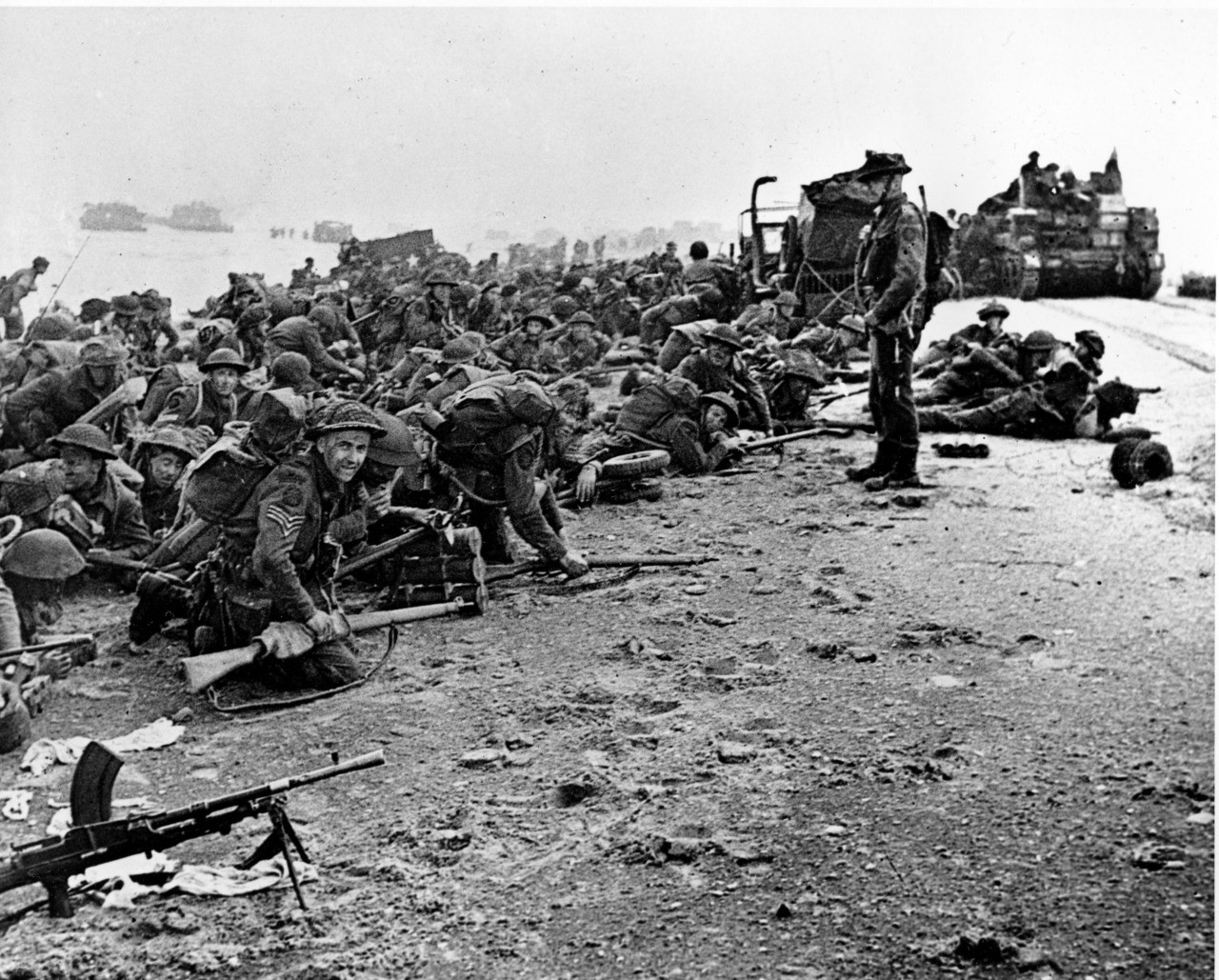
After landing at the shore, these British troops wait for the signal to move forward, during the initial Allied landing operations in Normandy, France, June 6, 1944. (AP Photo)
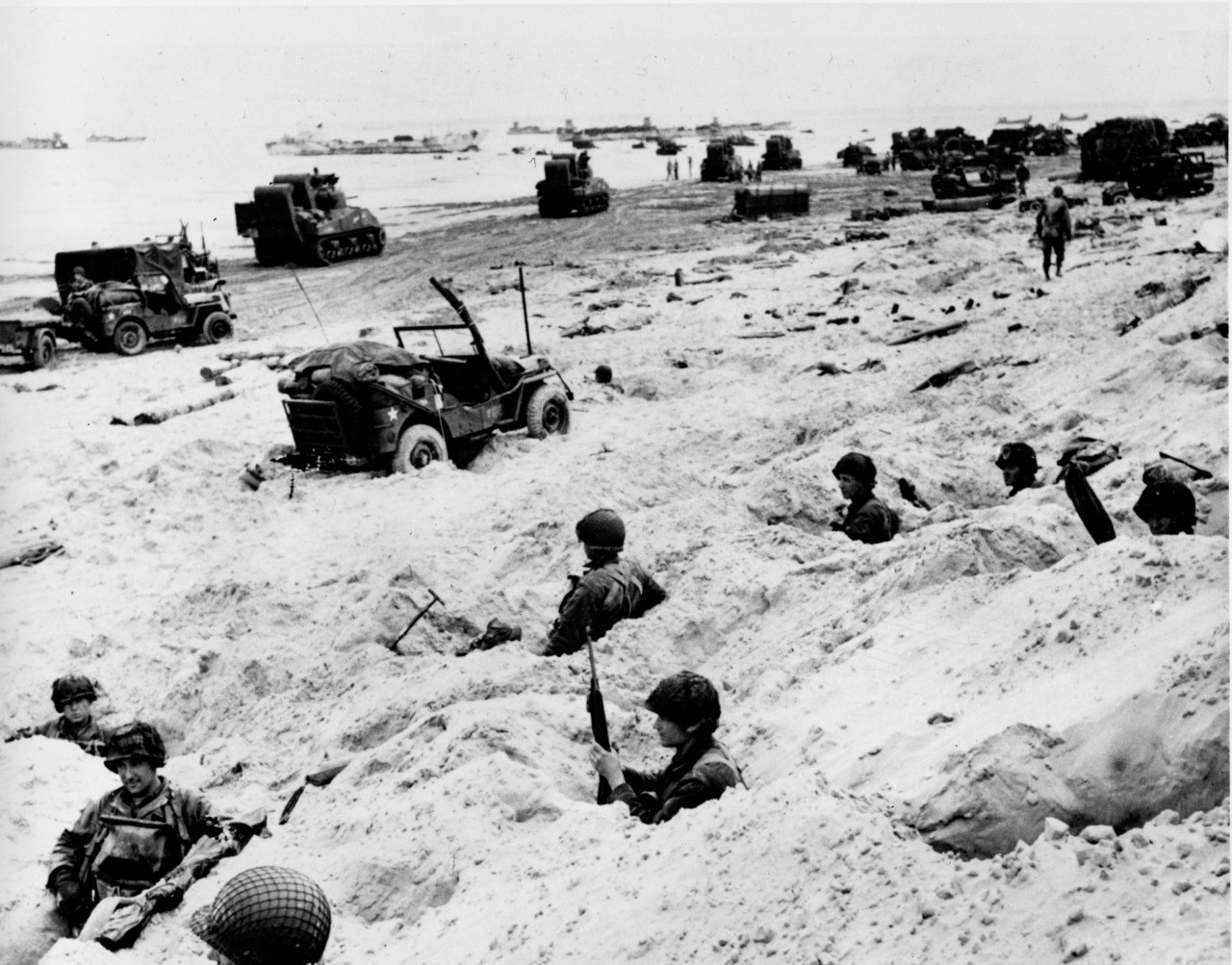
Sitting in the cover of their foxholes, American soldiers of the Allied Expeditionary Force secure a beachhead during initial landing operations at Normandy, France, June 6, 1944. In the background amphibious tanks and other equipment crowd the beach, while landing craft bring more troops and material ashore. (AP Photo/Weston Haynes)
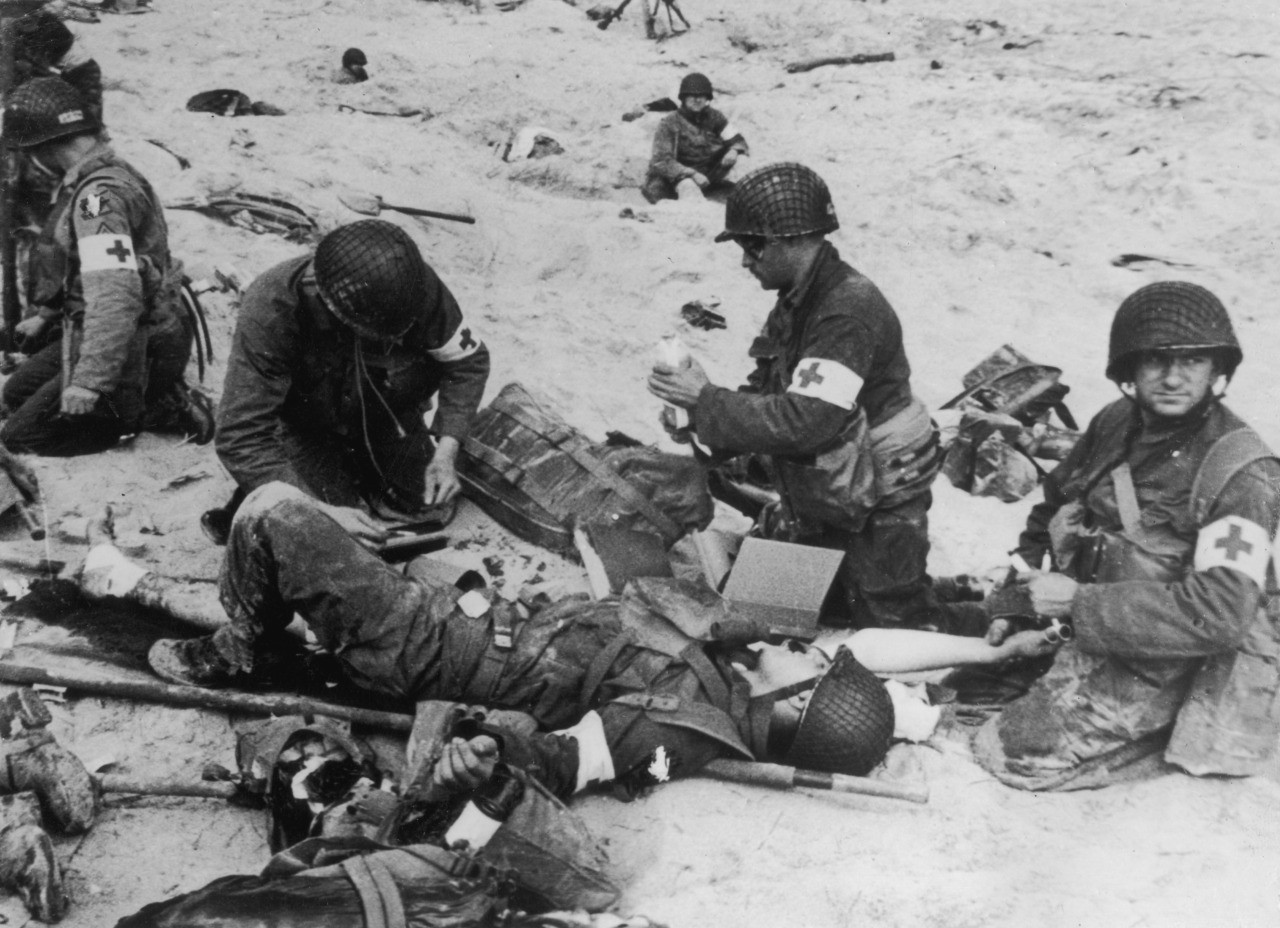
6th June 1944: American medics administer first aid to wounded soldiers on Utah beach in Normandy, France, whilst in the background other troops “dig-in” in the soft sand. (Photo by Hulton Archive/Getty Images)
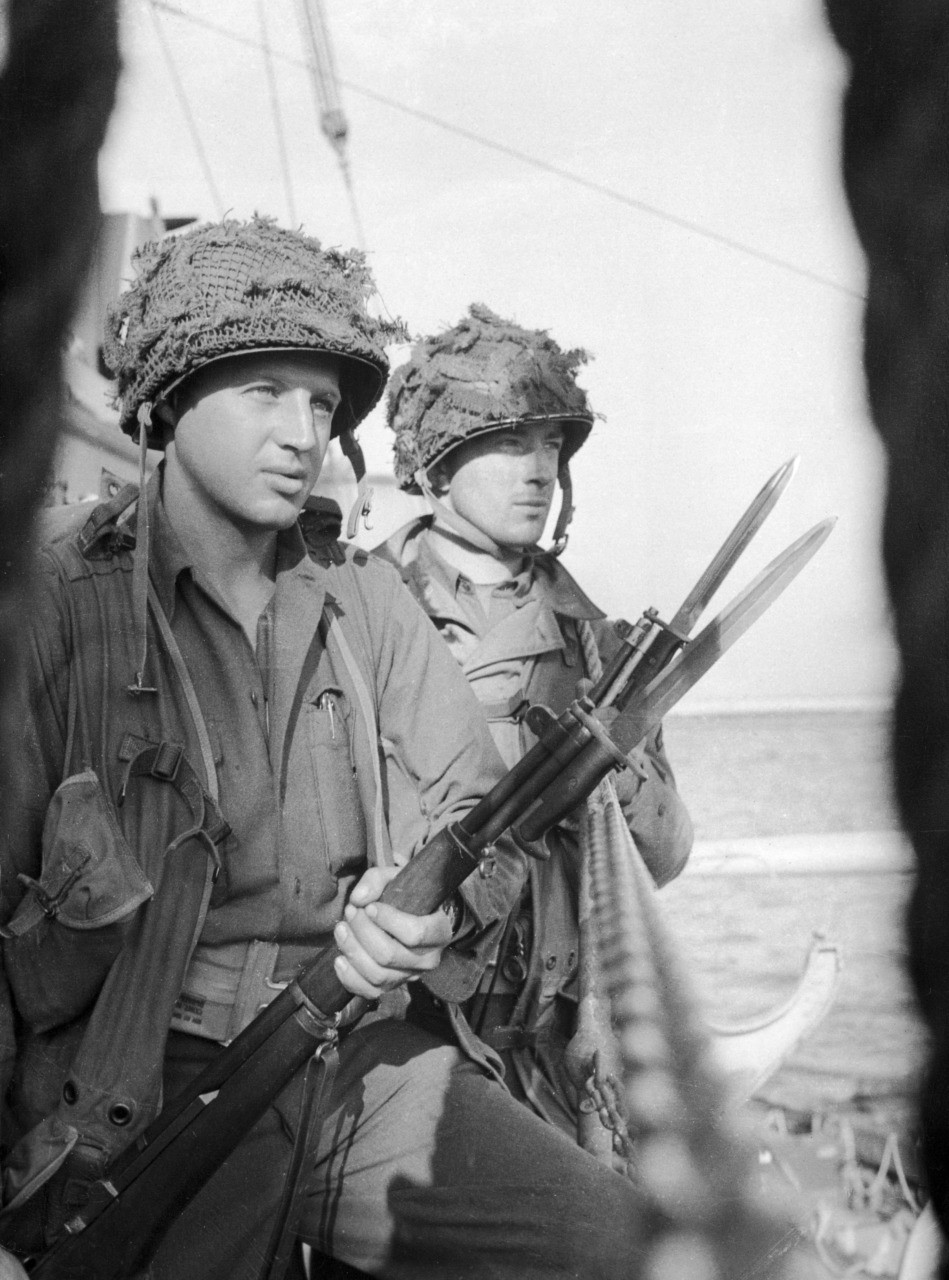
US troops landing in northern France on D-Day, 6th June 1944. (Photo by Hulton Archive/Getty Images)
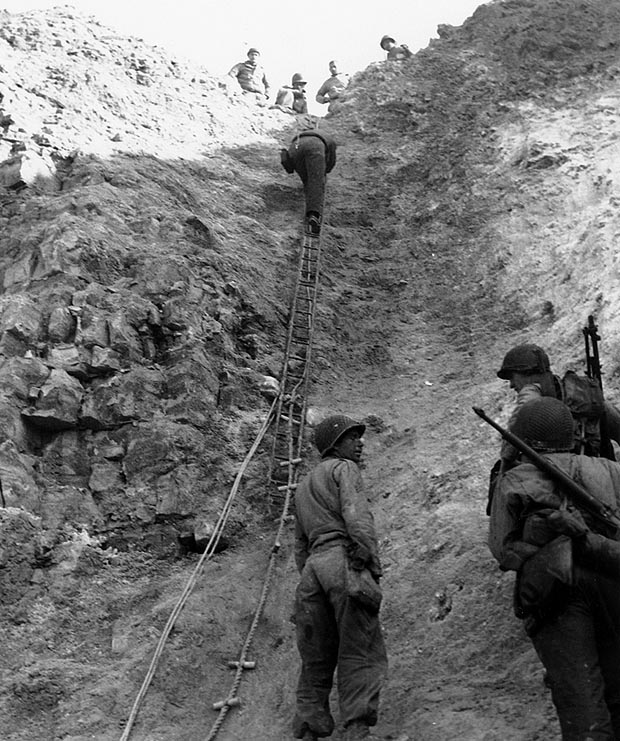
U.S. Army Rangers show off the ladders they used to storm the cliffs at Pointe du Hoc on D-Day. (Official U.S. Navy Photograph, now in the collections of the National Archives)

U.S. soldiers from the 2nd Ranger Battalion surround German prisoners 06 June 1944 on the Pointe du Hoc located on a cliff which overlooks Omaha Beach after Allied forces stormed the Normandy beaches during D-Day. Elements of the 2nd Ranger Battalion scaled the 100 foot cliff and seized the German artillery pieces that could have fired on the Allied forces landing at Omaha Beach. (AFP/Getty Images)

American troops advance over the crest of a concrete sea wall after the successful landings on Utah Beach in Normandy, France. (Photo by Keystone/Hulton Archive/Getty Images)
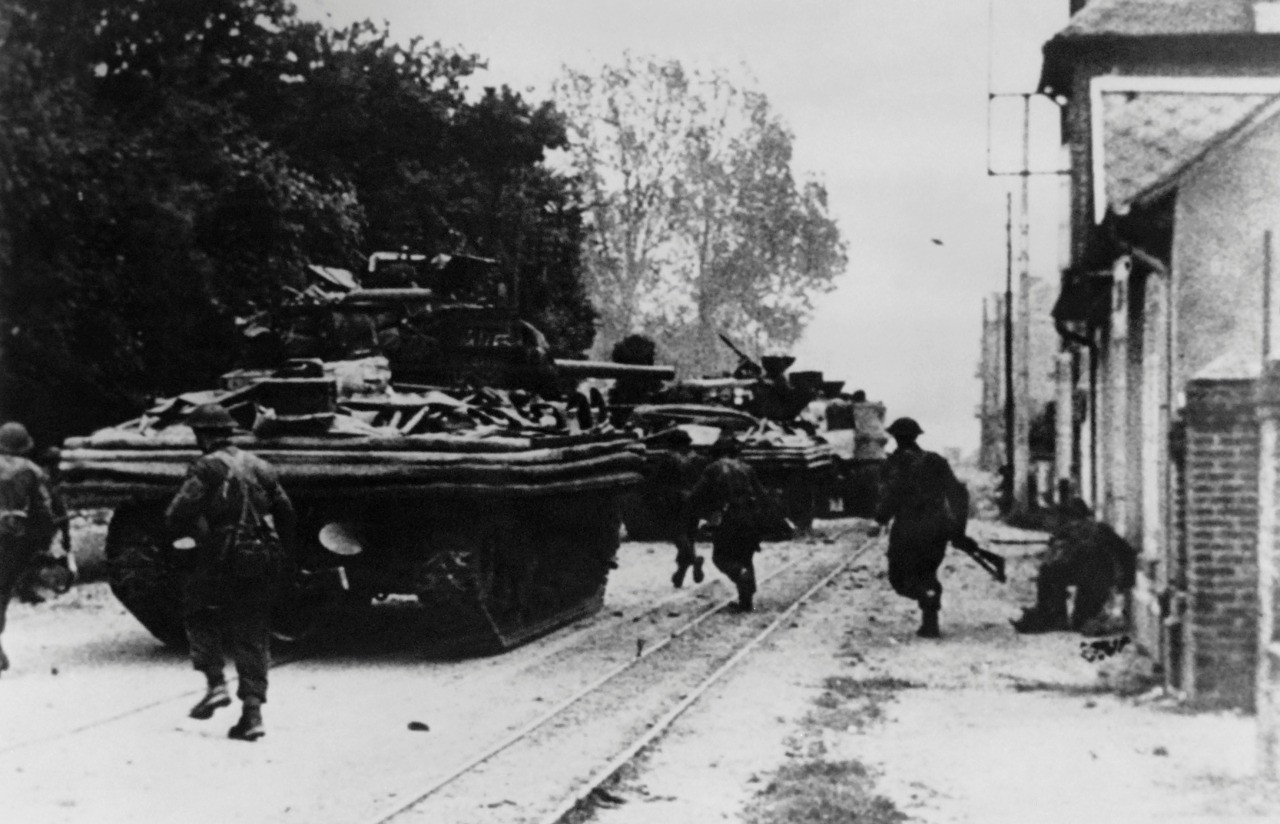
The first tanks entering the Sword Beach, near Ouistreham during the Normandy landing on 06 June 1944. (AFP/Getty Images)
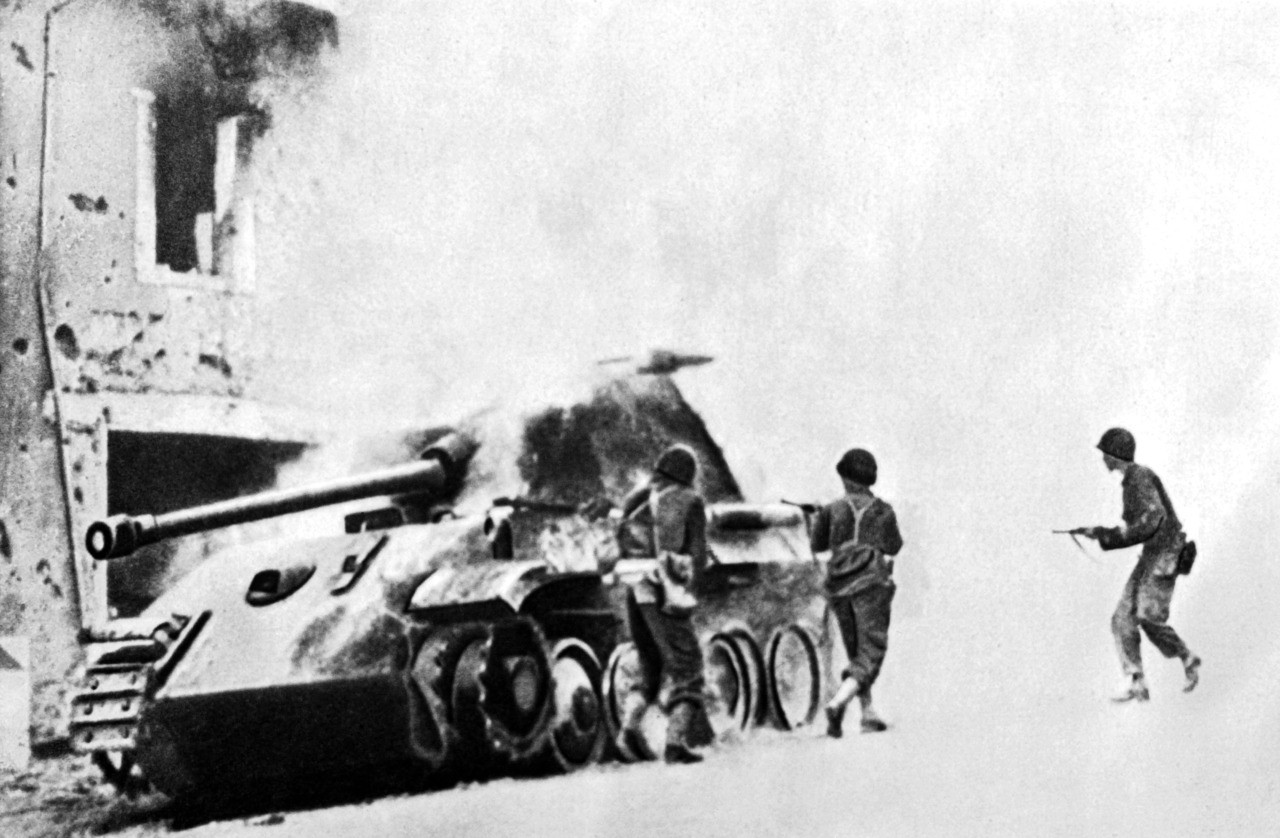
US soldiers surround a burning German tank in a Normandy village in June 1944 after Allied forces stormed the Normandy beaches during D-Day. (AFP/Getty Images)
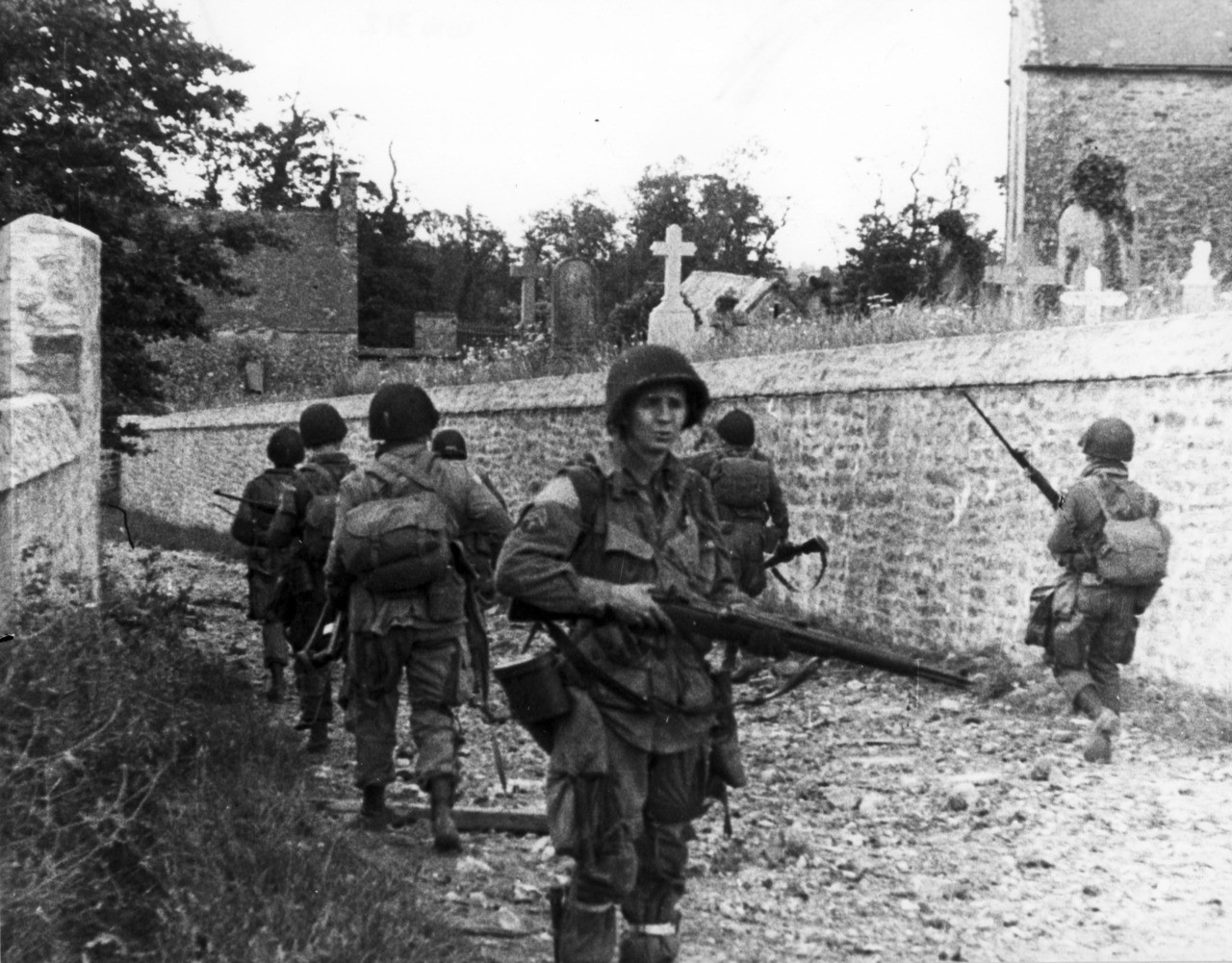
6th June 1944: American paratroopers having made successful landings at Utah Beach, advance cautiously through a French cemetery at St Marcouf. (Photo by MPI/Getty Images)
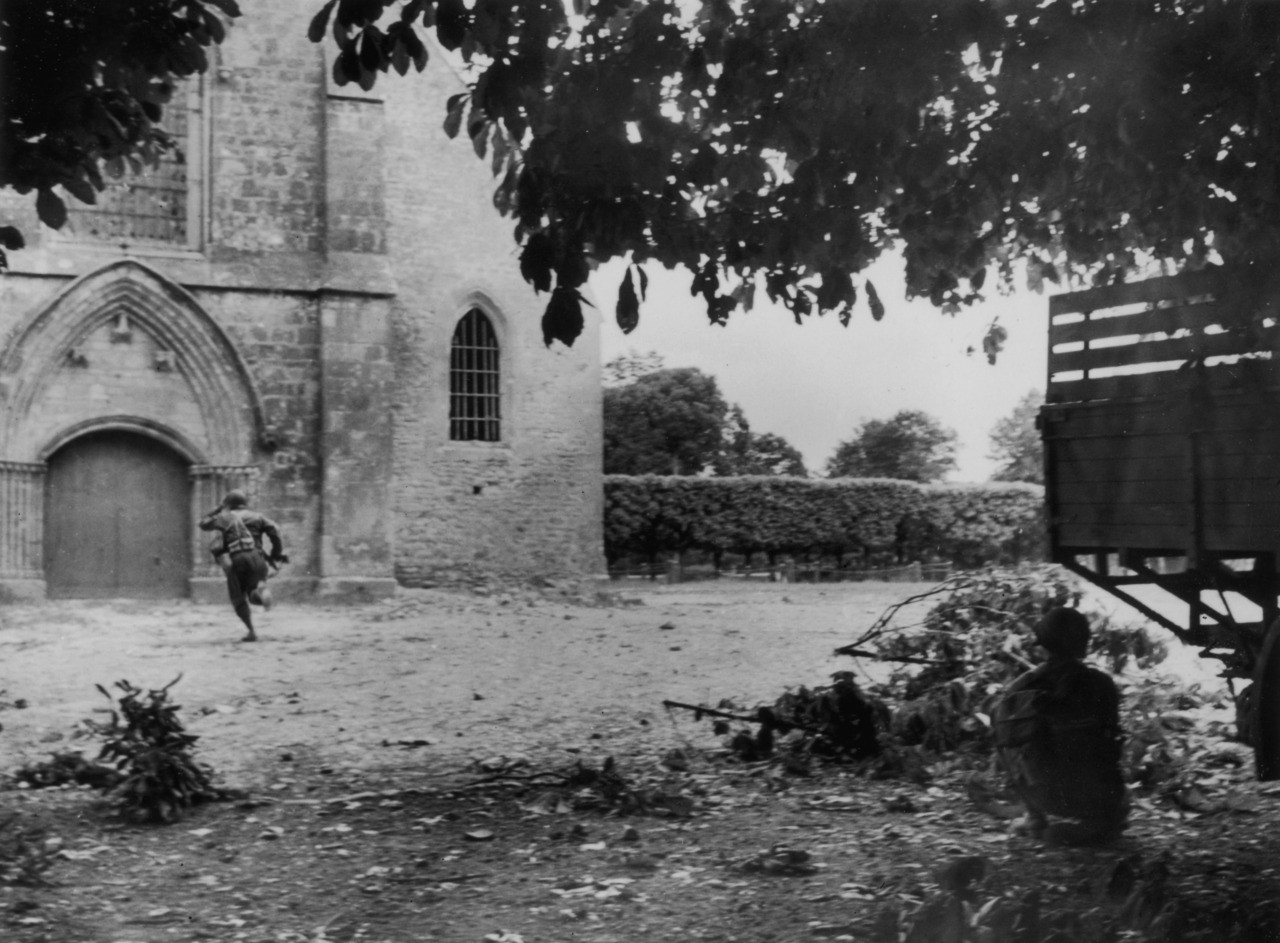
7th June 1944: Soldiers try to flush out a German sniper located in a church in the centre of Sainte Mere Eglise, after the Normandy town’s liberation. (Photo by Bob Landry/Keystone/Hulton Archive/Getty Images)
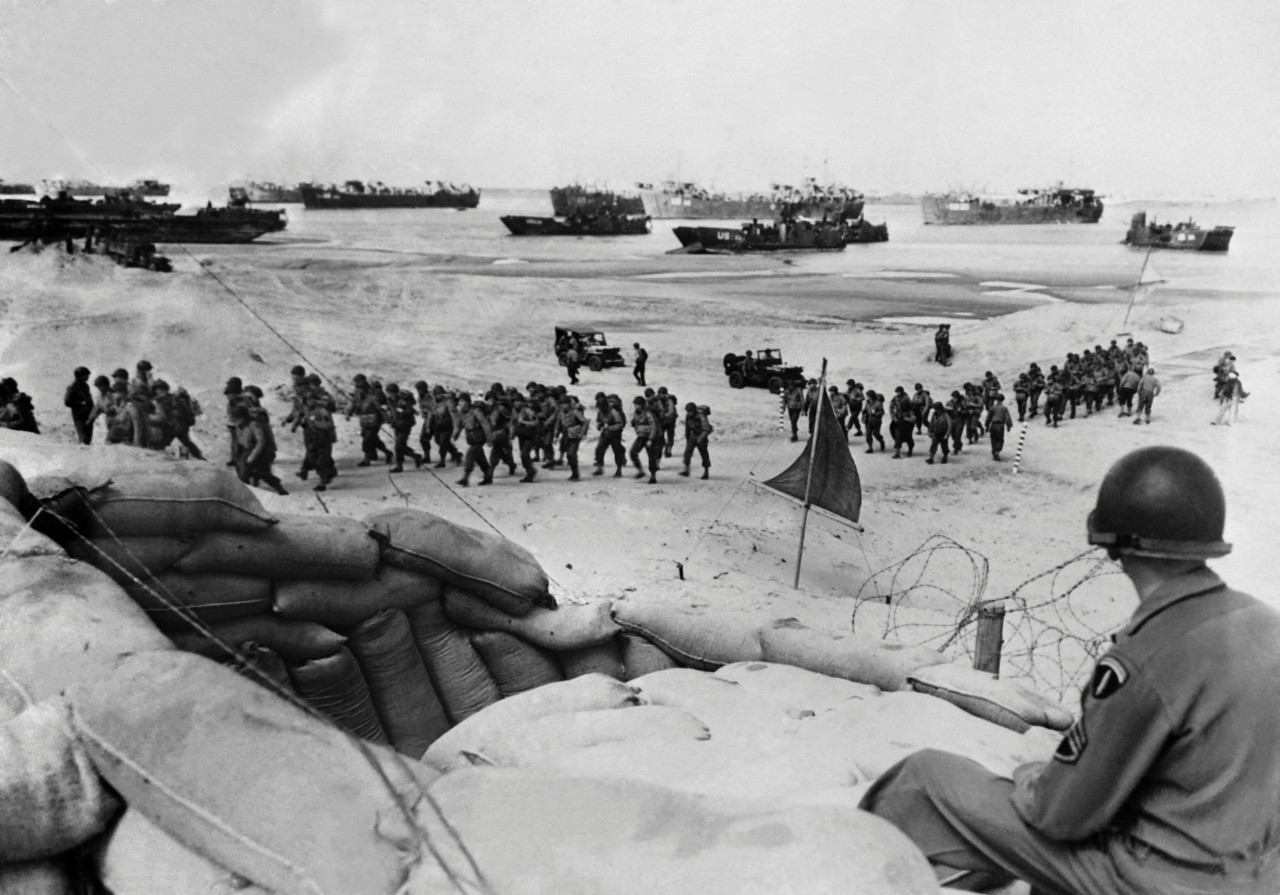
Soldiers of the Allied Expeditionary Corps arrive on a beach on June 6, 1944 after Allied forces stormed the Normandy beaches during D-Day. (AFP/Getty Images)
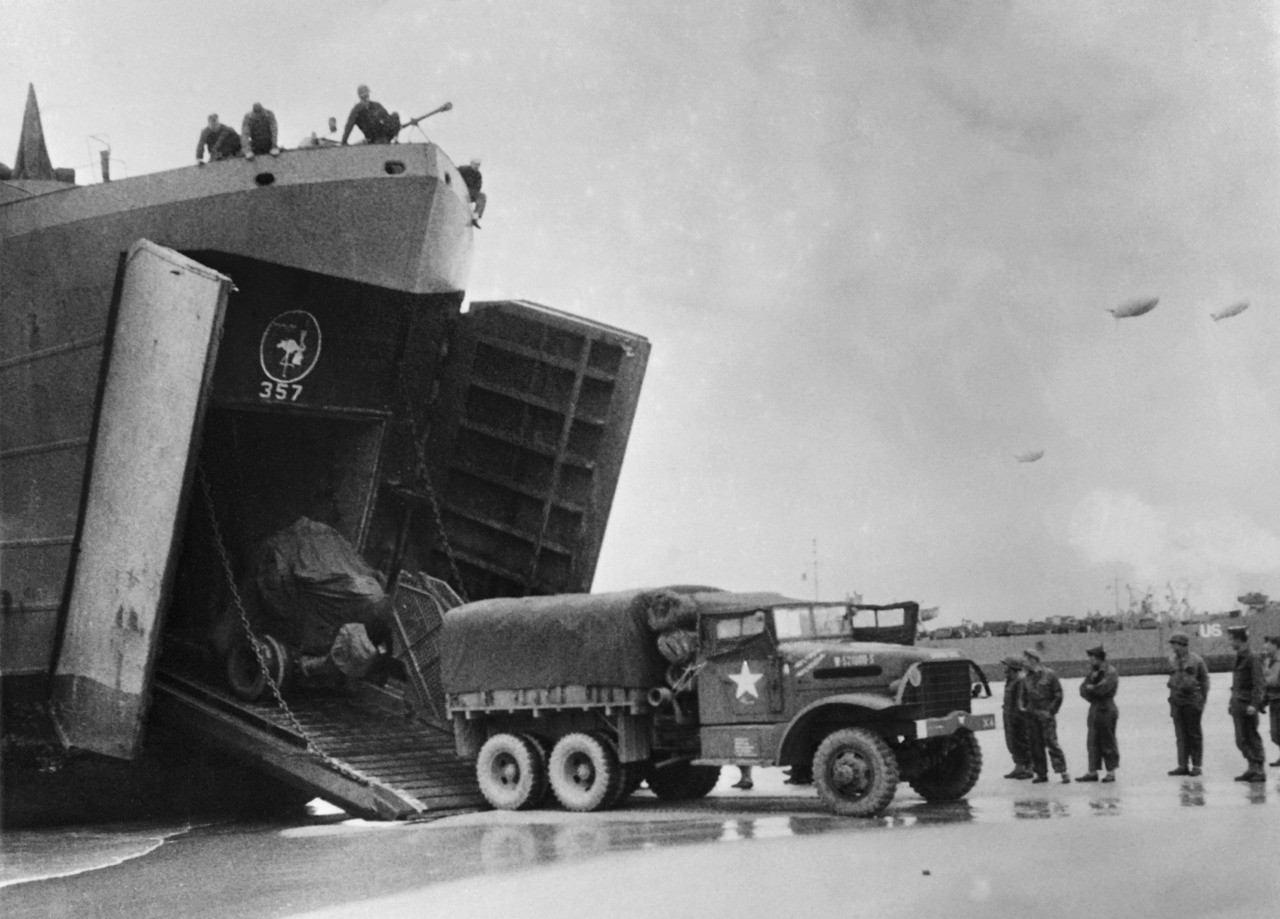
US soldiers gather around trucks disembarking from crafts shortly after D-Day 06 June 1944 after Allied forces stormed the Normandy beaches. (AFP/Getty Images)

Supreme Commander of the Allied Forces, General Dwight D. Eisenhower (L) shows the strain of his command as he and Britain’s Field Marshal Bernard Montgomery (R), his deputy commander, confer on the invasion plans of Normandy in an unknown location in June 1944 after Allied forces stormed the Normandy beaches on D-Day. (AFP/Getty Images)
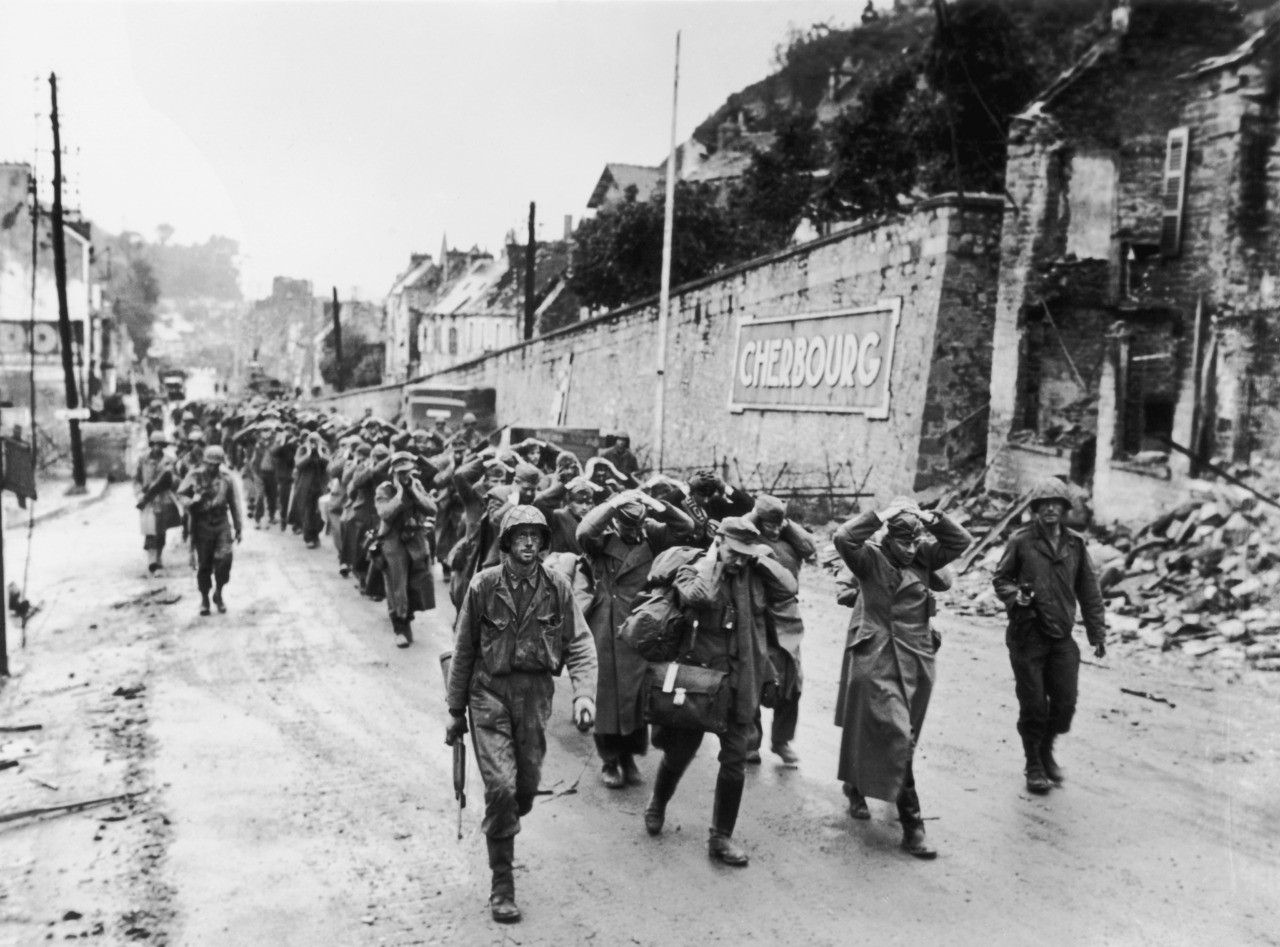
June 1944: German soldiers are seen here being marched through the streets of Cherbourg, France, after the city was liberated by the Americans. (Three Lions/Getty Images)
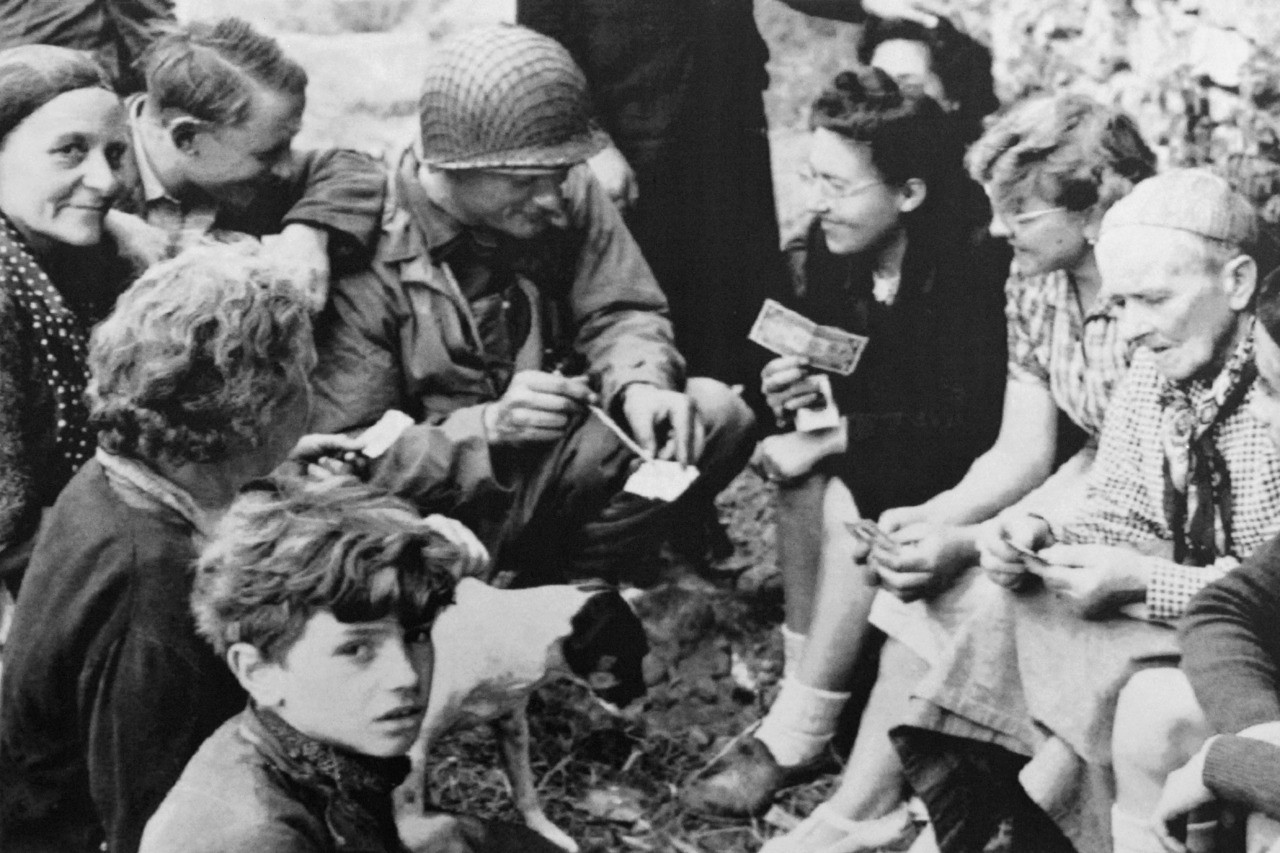
Joseph Vaghi (C), a US Navy ensign, chats with residents of Colleville-Sur-Mer in June 1944 after Allied forces stormed the Normandy beaches during D-Day. (AFP/Getty Images)
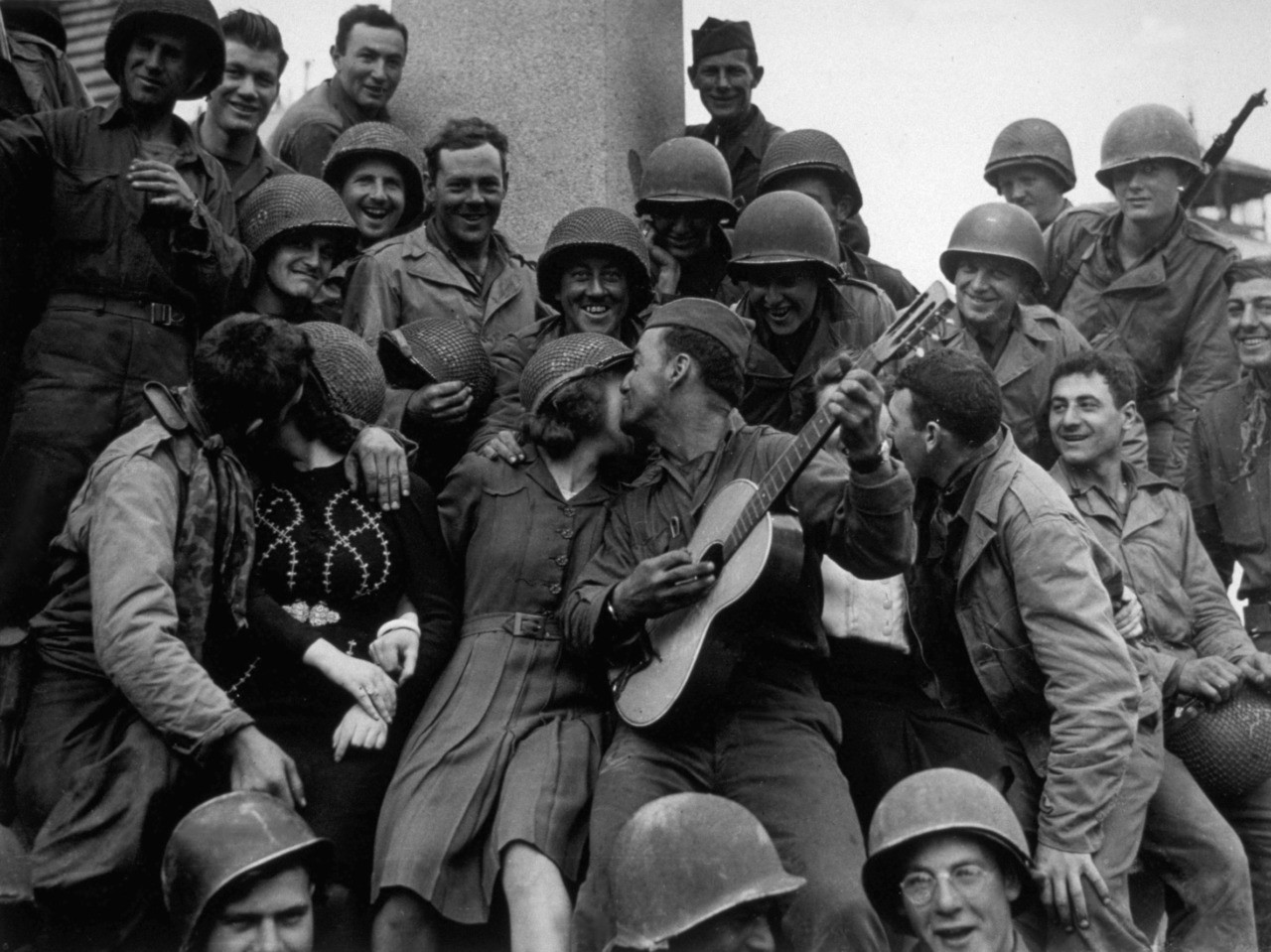
June 1944: A happy crowd of American soldiers receive a warm welcome from the inhabitants of Cherbourg, after its liberation. (Photo by Keystone/Getty Images)
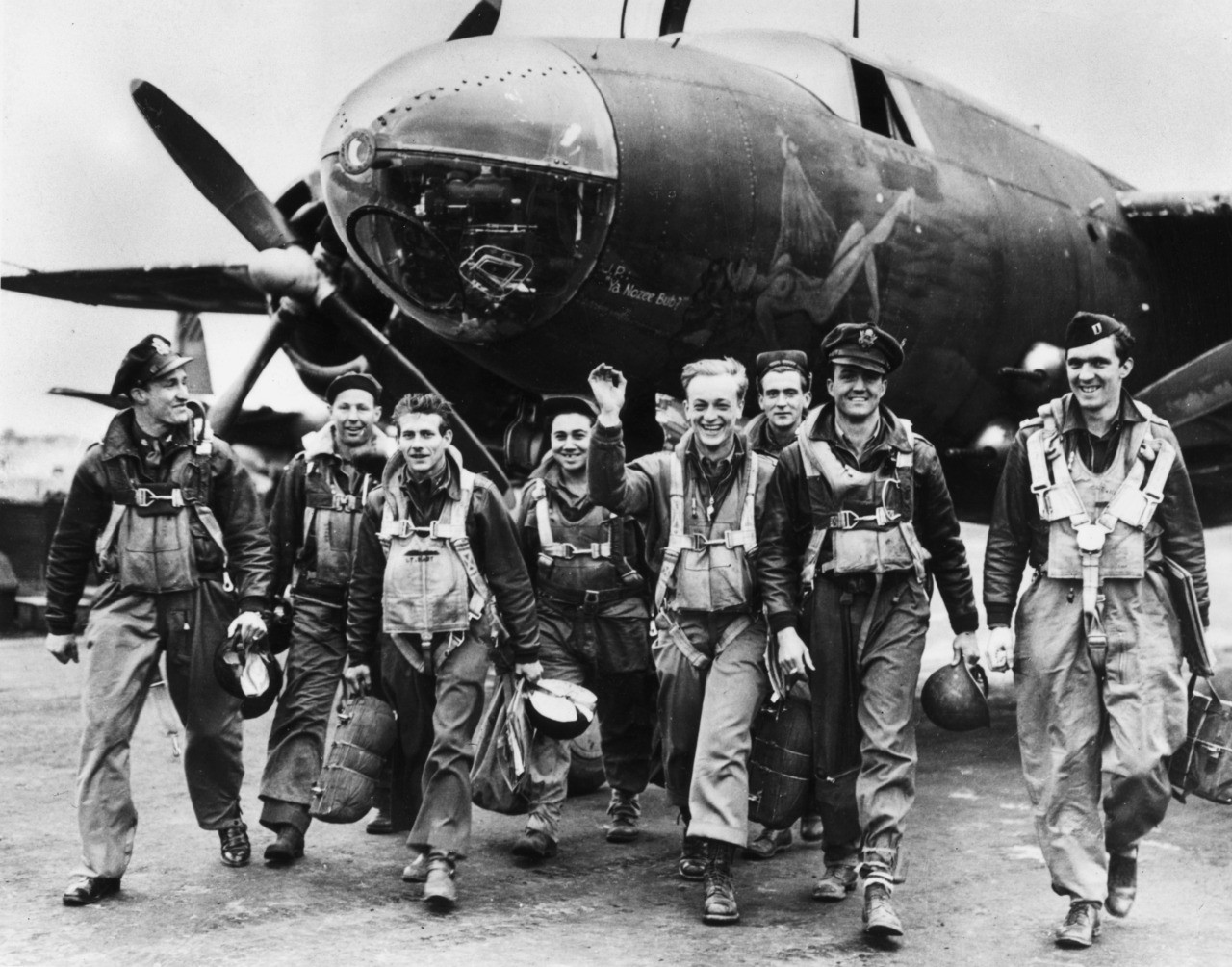
7th June 1944: Bomber crews of the US Ninth Airforce leave their B26 Marauder aircraft after returning from a mission to support the D-Day landings in Normandy by disrupting German lines of communication and supply. (Photo by Fred Ramage/Keystone/Hulton Archive/Getty Images)

6th June 1944: People in the City of London rush to buy the first newspapers giving news of the Allied D-Day landings in Normandy. (Photo by Fred Morley/Fox Photos/Getty Images)

In Piccadilly Circus crowds of Londoners read the first news of the invasion in the editions of the evening papers, June 6, 1944. (AP Photo)
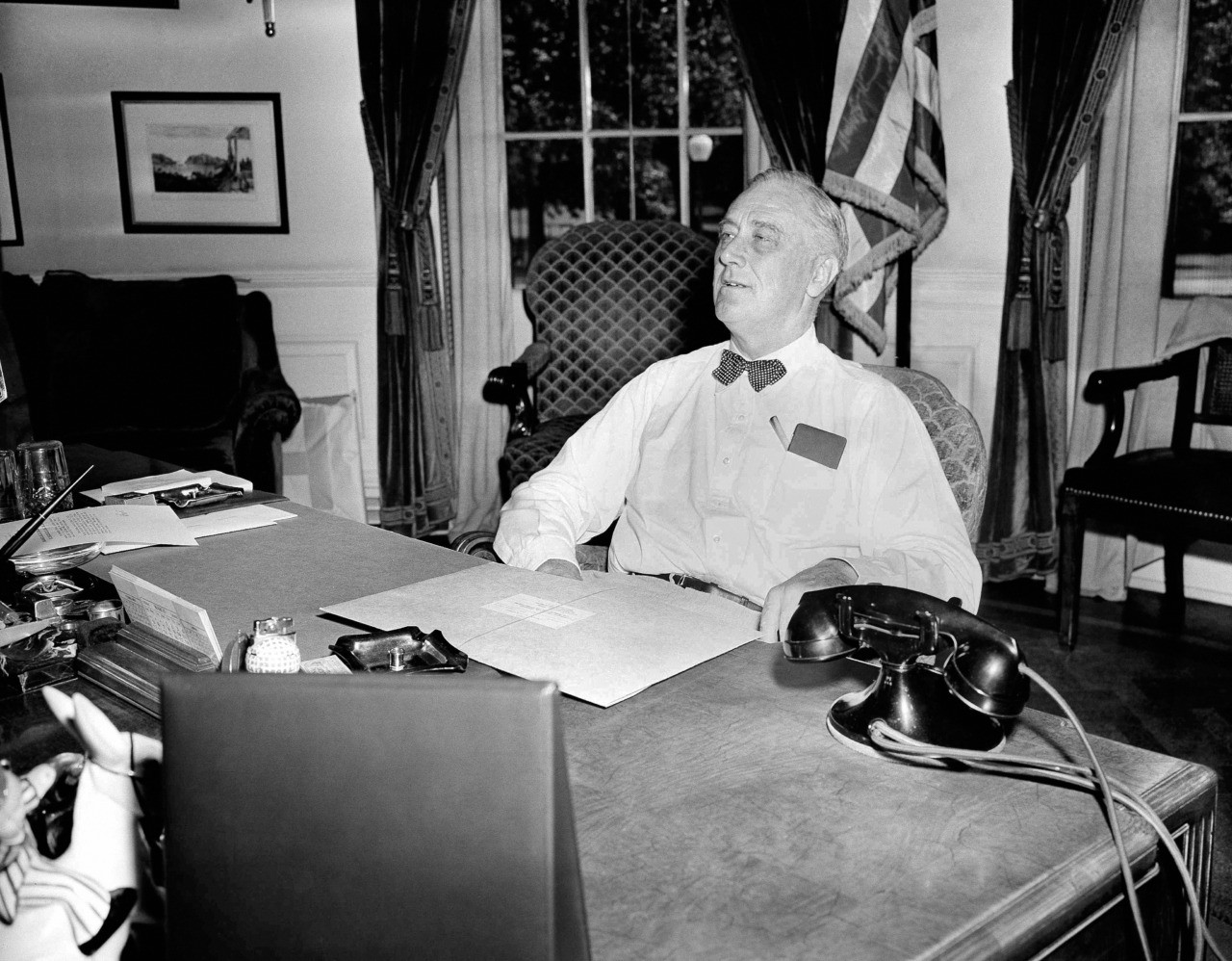
U.S. President Franklin D. Roosevelt wears an expression of confidence and determination as he receives visitors in his White House office on this long-awaited D-Day of the start of the western European invasion in Washington on June 6, 1944. (AP Photo)
On the evening of June 6, 1944, President Franklin Roosevelt delivered a radio address informing the American people that the liberation of Europe was under way.
The president then asked his fellow Americans to join him in prayer as he beseeched Almighty God’s protection for “our sons, the pride of our nation” who were engaged that day “upon a mighty endeavor, a struggle to preserve our Republic, our religion, and our civilization, and to set free a suffering humanity.”
The following is the audio of President Roosevelt’s D-Day prayer broadcast to the nation that night:
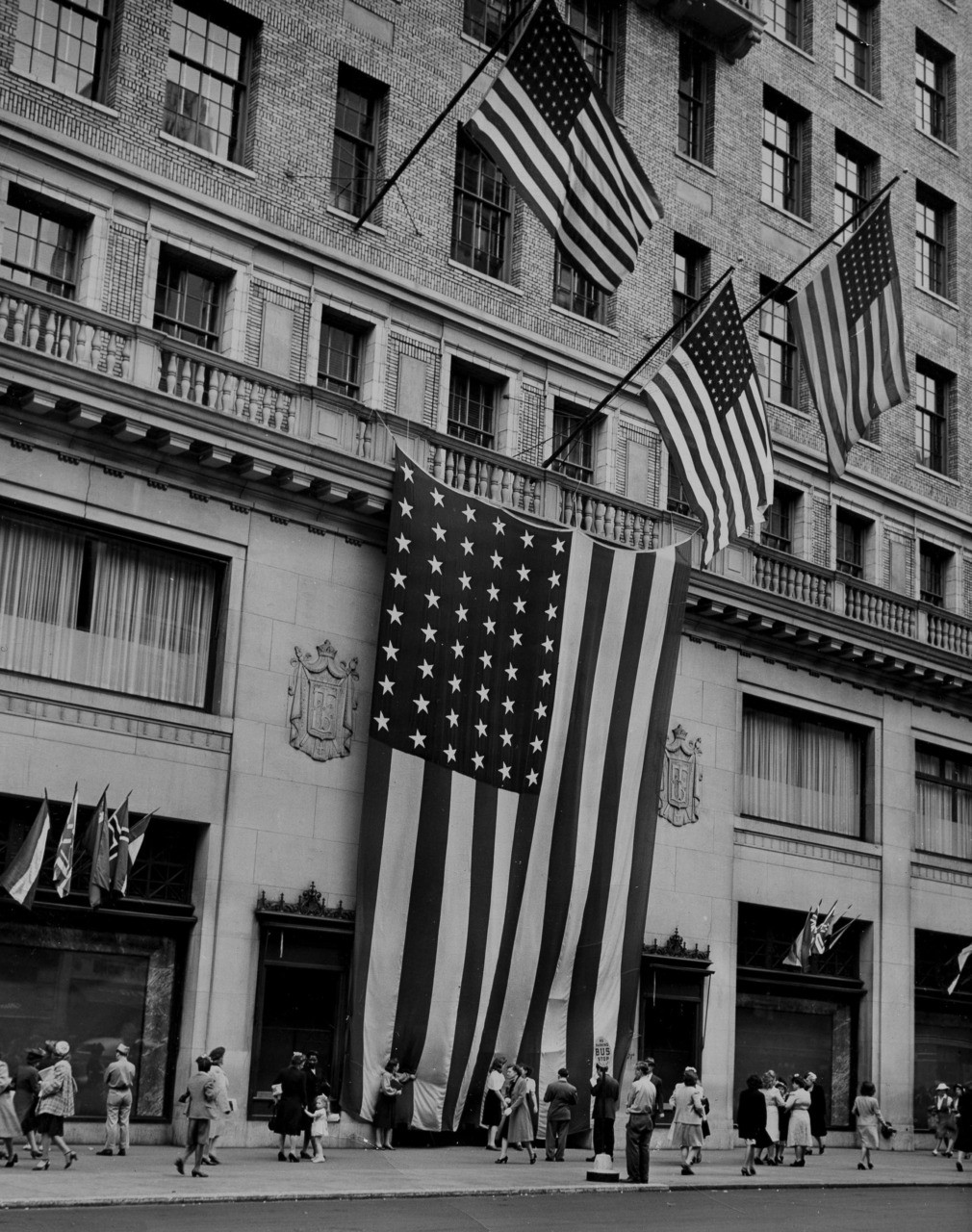
Observing D-Day in a big fashion, Lord & Taylor department store displays a 27 by 40 foot American flag down the front of its building in New York, June 7, 1944. The store closed its doors from 11 a.m. on. (AP Photo/RM)
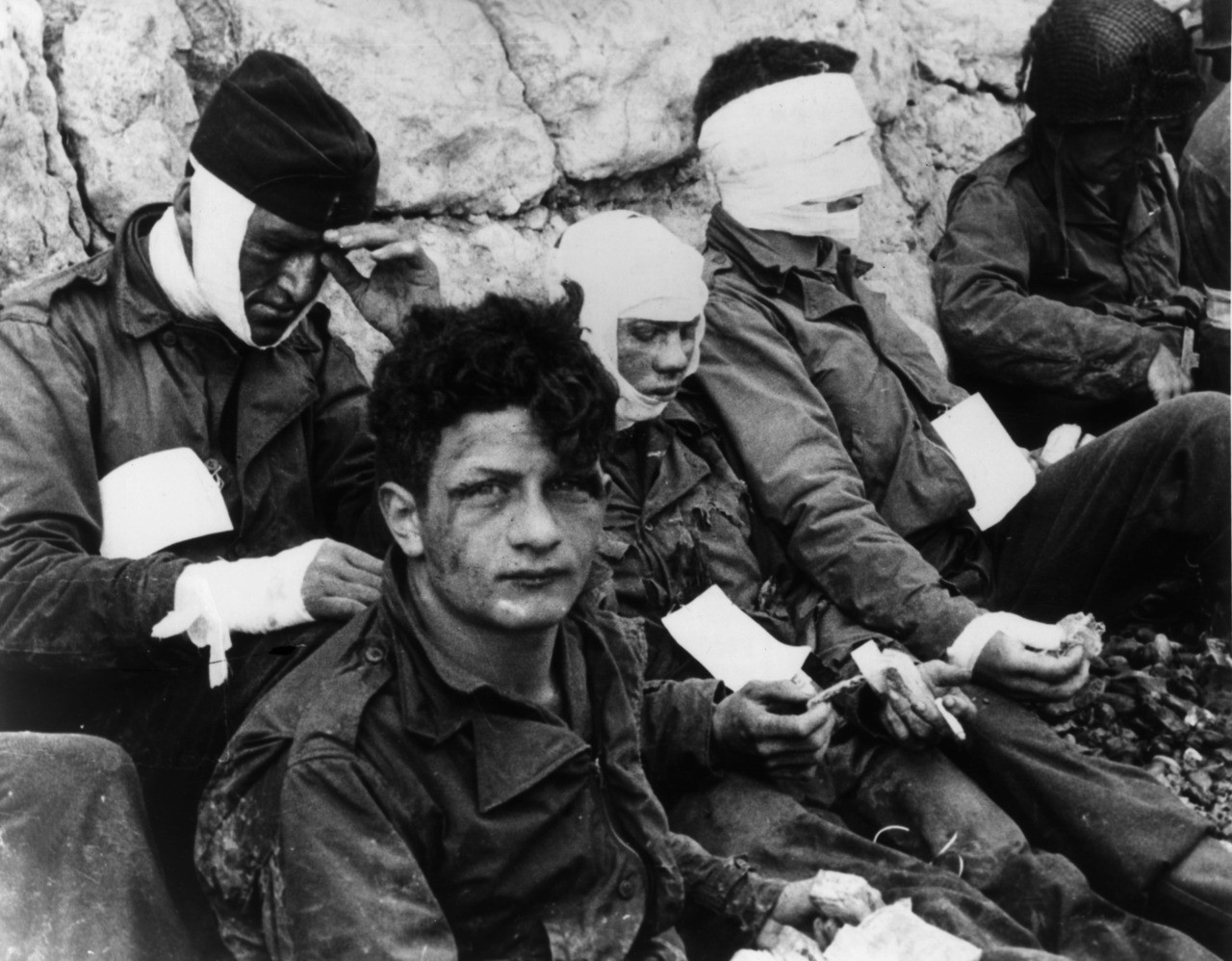
6th June 1944: Wounded US soldiers of the 3rd Battery, 16th Infantry Regiment, 1st US Infantry Division, lean against chalk cliffs while eating and smoking after storming Omaha Beach in Normandy, Colleville-Sur-Mer, France during World War II. Some of the men wear head bandages. (Photo by Taylor/US Army/Getty Images)
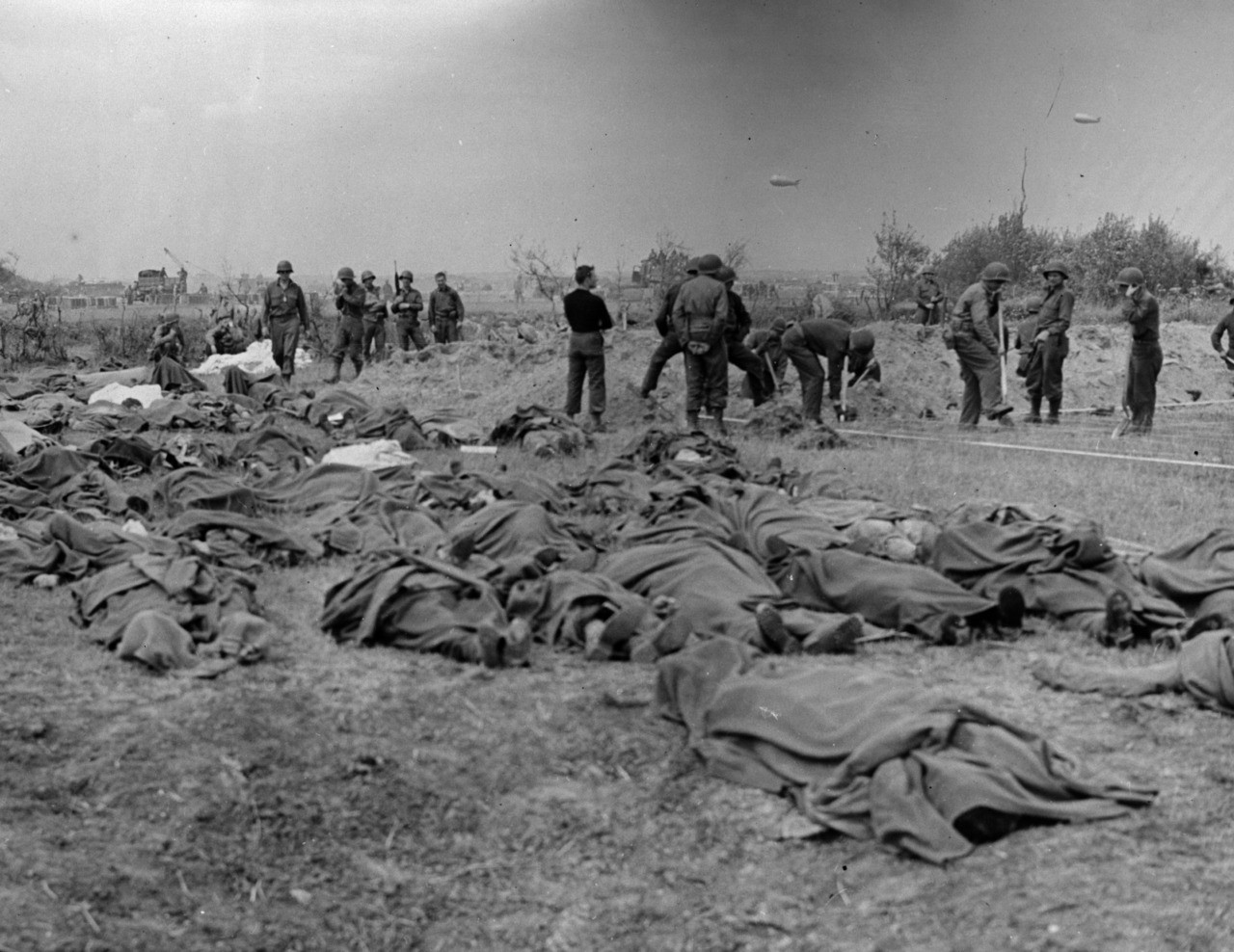
June 1944: The bodies of American soldiers lie on the ground in Normandy, France, awaiting burial, following the D-Day Allied invasion. (Photo by Fox Photos/Getty Images)

June 1944: Medical orderlieswith the dead ready for burial in one of the first invasion graveyards in France. (Photo by Keystone/Getty Images)

As old glory is held in final salute a memorial service to the men who fell in the allied invasion of France is held at the first American cemetery to be laid out in Normandy on June 15, 1944. (AP Photo)

17th June 1944: A wooden cross, a soldier’s helmet, and flowers mark the grave of an American soldier who was killed in battle during the invasion of Normandy, Carentan, France. A sign posted by French civilians reads ‘Mort pour la France’, or ‘Died for France.’ (Photo by Himes/US Army/Getty Images)

Row after row of white crosses mark the U.S. Military Cemetery No. 2 at Ste. Mere Eglise in Normandy, France on May 15, 1946. In the background is the town, which was taken by American troops driving to cut off the Cotentin peninsula during the early days of the invasion. (AP Photo/Max Nash)
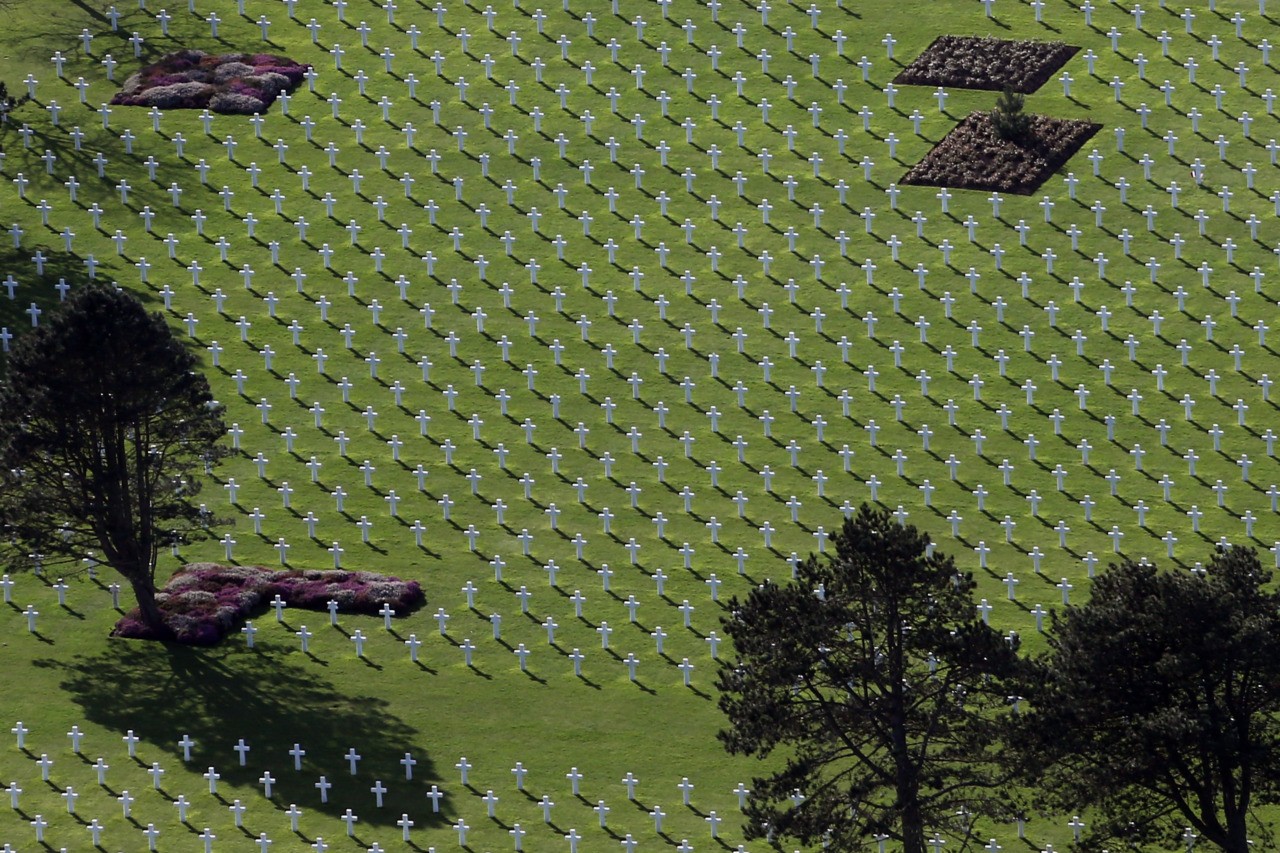
The American War cemetery of Colleville sur Mer is pictured Tuesday, April 8, 2014, Normandy, France. The cemetery overlooks Omaha Beach, one of the landing beaches of the Normandy Invasion, and contains the remains of 9,387 American military dead, most of whom were killed during the invasion of Normandy and ensuing military operations in World War II. (AP Photo/David Vincent)
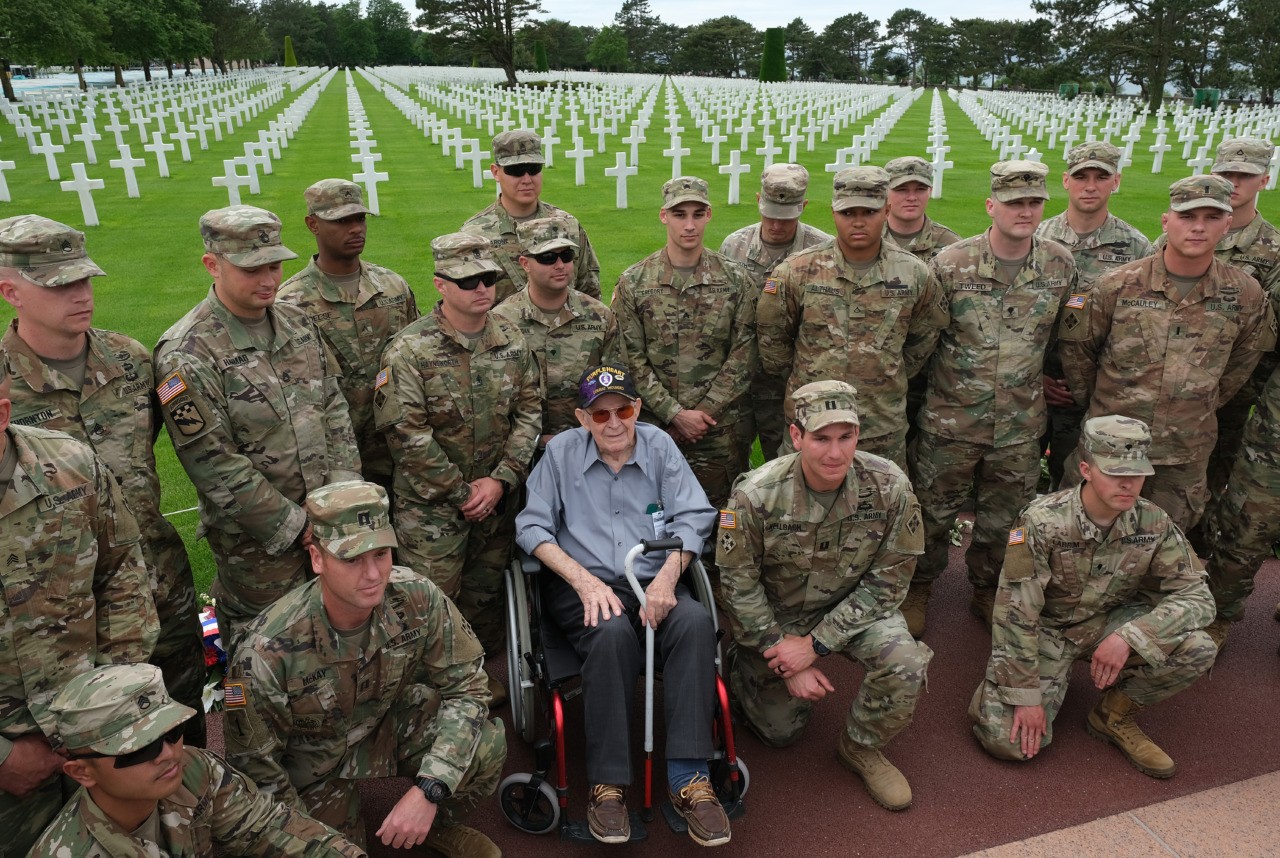
COLLEVILLE-SUR-MER, FRANCE: Soldiers of the U.S. Army pose for a photo with U.S. D-Day veteran Leonard Jindra, 98, following a small ceremony at Normandy American Cemetery on June 02, 2019 near Colleville-sur-Mer, France. Jindra served in the U.S. 115th Infantry Regiment of the 29th Infantry Division and landed at Omaha Beach on June 6, 1944 in the Allied D-Day invasion. (Photo by Sean Gallup/Getty Images)
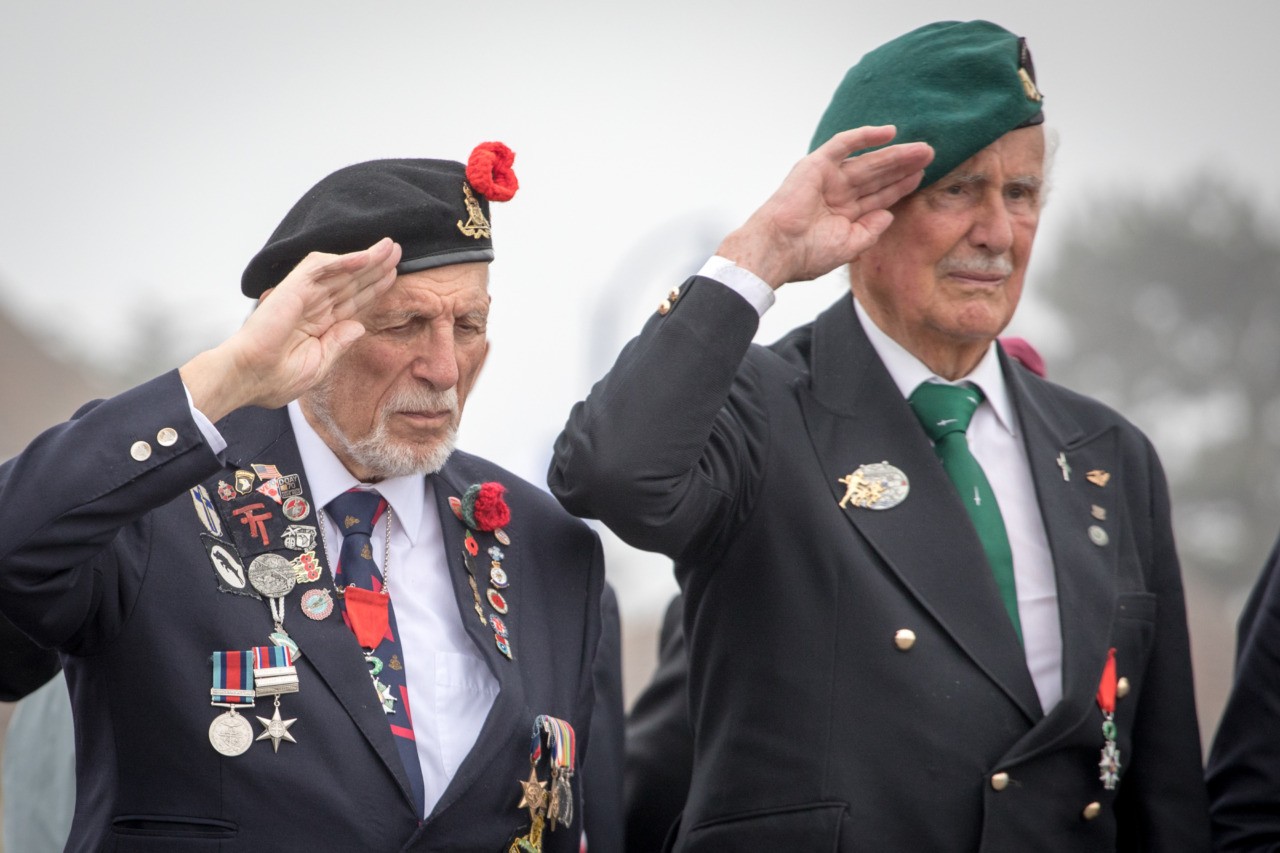
COLLEVILLE-MONTGOMERY, FRANCE – JUNE 08: Normandy veterans Joe Cattini, 95, who was in the Hertfordshire Yeomanry (L) and landed on Gold Beach on D-Day and Roy Maxwell, 96, (R) who was in 4 Commando and landed Sword Beach on D-Day, salute as they attend at a memorial ceremony at the Bill Millin memorial near Sword Beach at Colleville-Montgomery, on June 8, 2018 near Caen, France. (Photo by Matt Cardy/Getty Images)
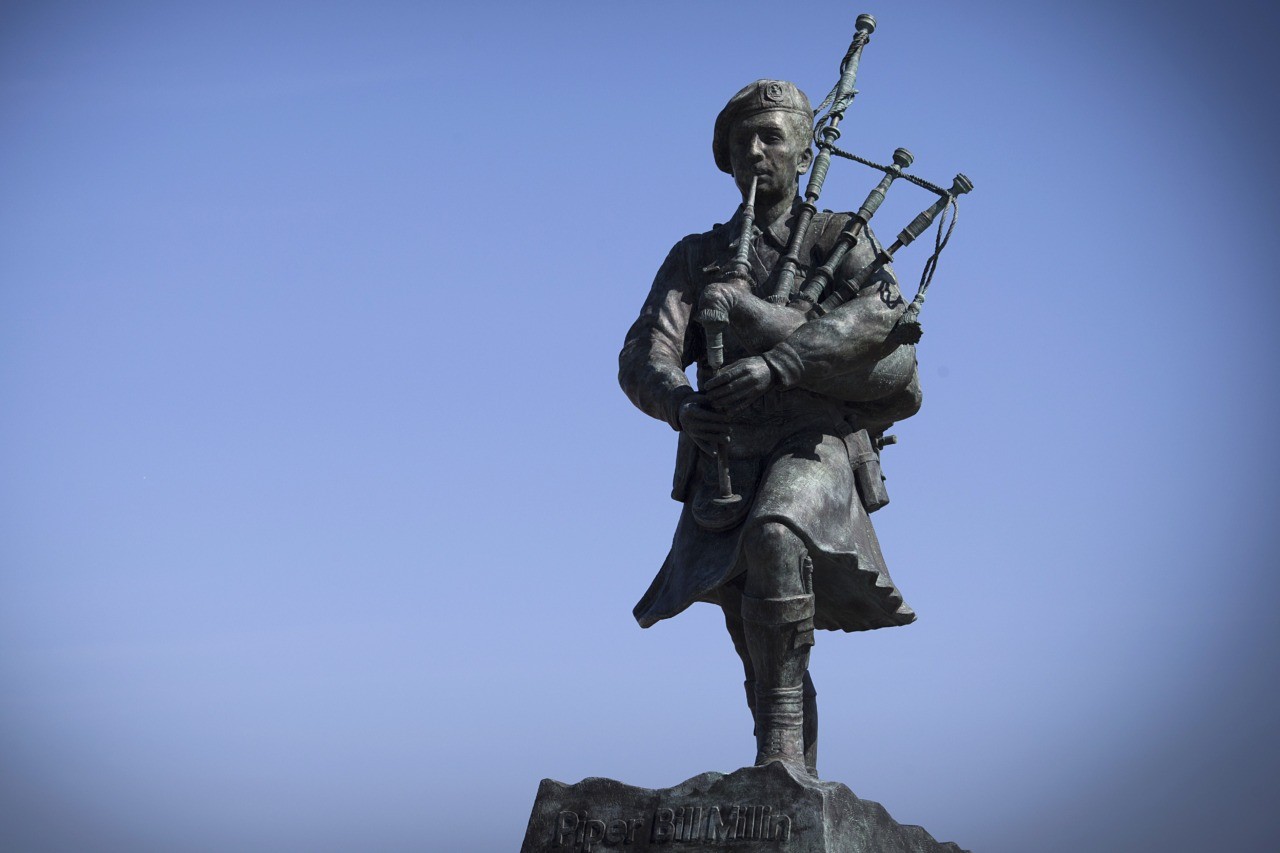
The statue of Bill Millin, best known as “Piper Bill,” in Ouistreham, northern France. Bill Millin was Scotland Lord Lovat’s personal piper and played bagpipes during D-Day on June 6, 1944 on Sword beach. (JOEL SAGET/AFP/Getty Images)

World War II veteran Charles Norman Shay, a Penobscot Native American, who took part in the Operation Overlord on June 6, 1944, poses on May 4, 2019 in Omaha Beach, western France. (LOIC VENANCE/AFP/Getty Images)
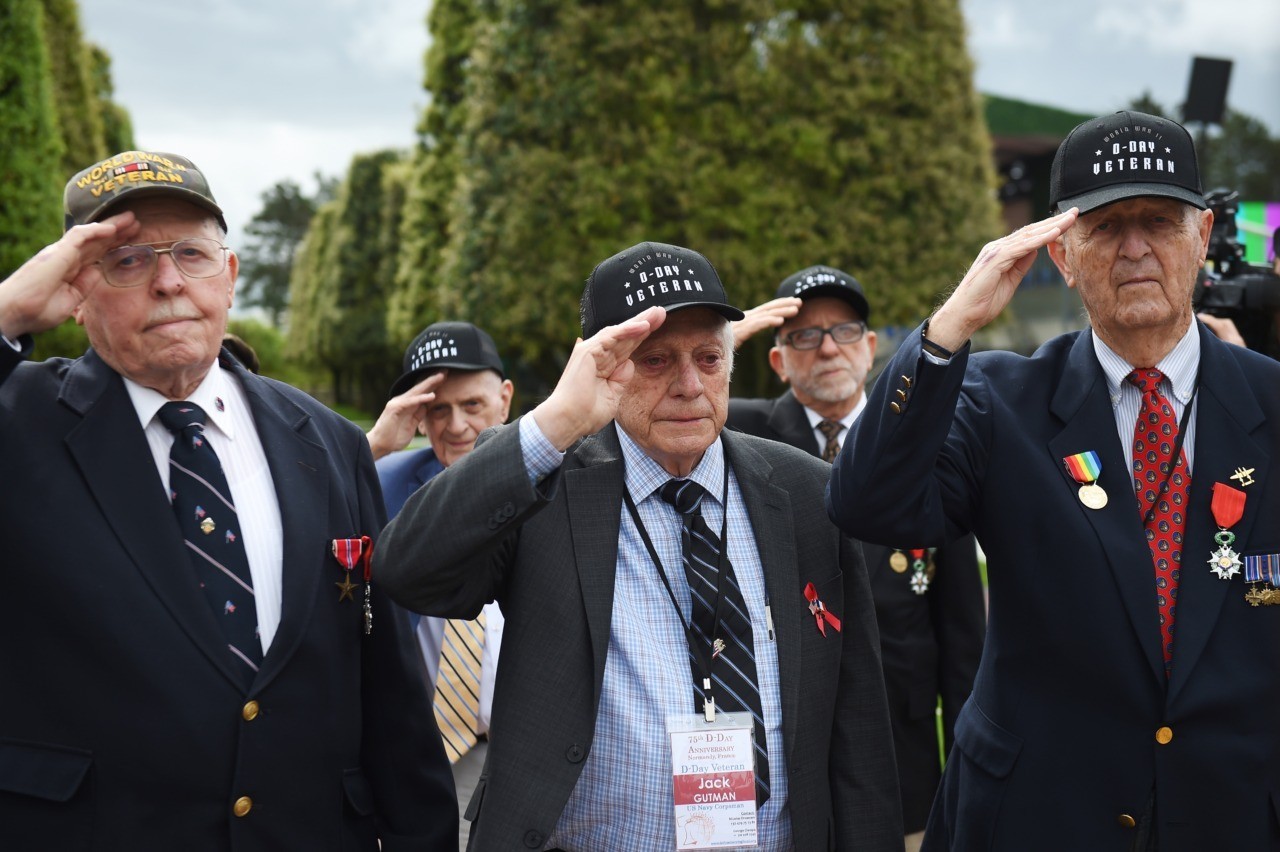
US veterans Jack Gutman (C), Georges Ciampa (2R) and James Forlking (R), who all landed on “Omaha Beach” on June 6, 1944, salute as they listen to the US national anthem during a ceremony at the American Cemetery in Colleville-sur-Mer, north-western France, on June 5, 2019, in memory of fallen American soldiers who took part in the World War II Allied landings in Normandy. (GUILLAUME SOUVANT/AFP/Getty Images)
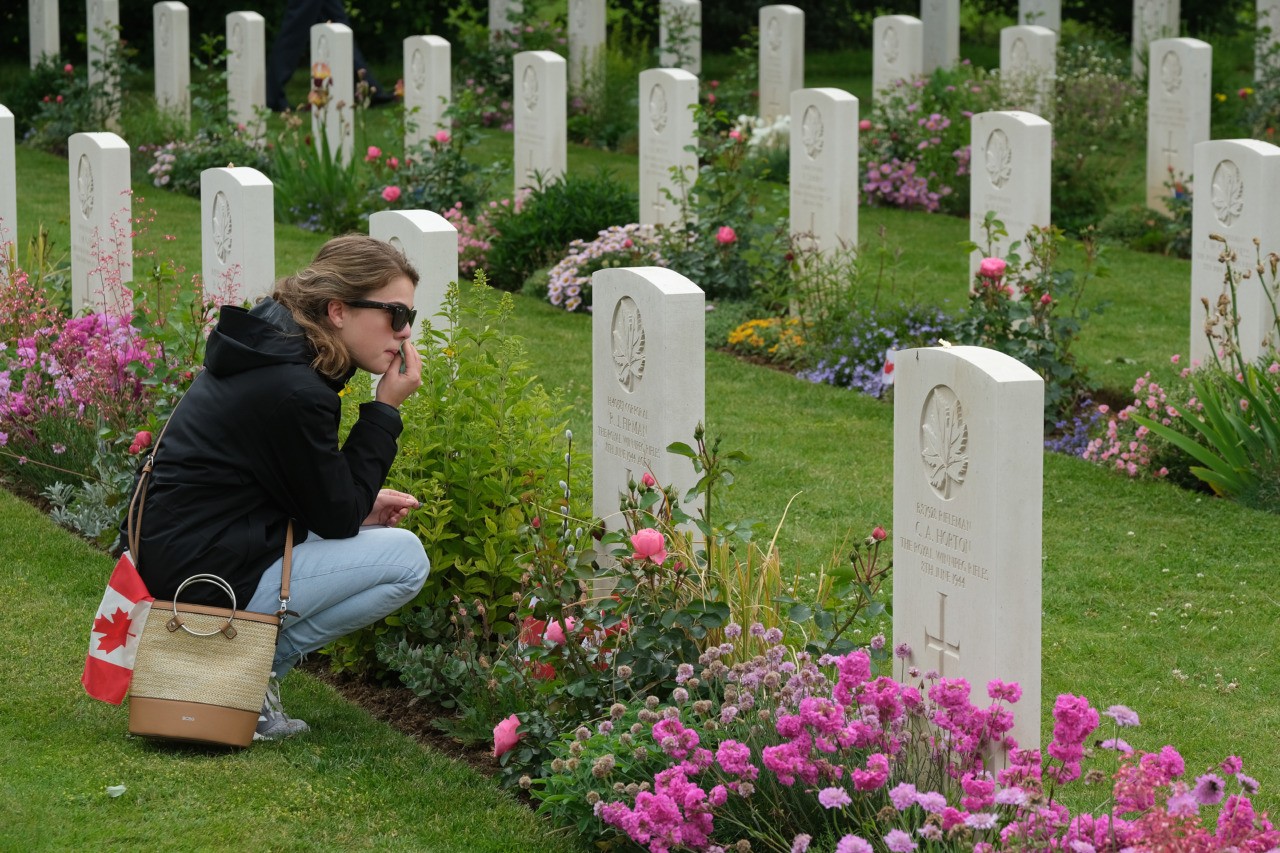
REVIERS, FRANCE – JUNE 05: Lise Belanger, 18, wipes an eye as she kneels at the gravestone of her great-uncle, Roger “Sonny” Firman, at the Commonwealth War Graves Commission’s Beny-sur-Mer Canadian War Cemetery in Normandy on June 05, 2019 near Reviers, France. Sonny, a 21-year-old serving in the Canadian Royal Winnipeg Rifles, landed on June 6, 1944, at Juno Beach in the Allied D-Day invasion during World War II. He was captured by the Germans and on June 8, together with other Canadian prisoners of war, was executed by a unit of the Waffen SS. (Sean Gallup/Getty Images)

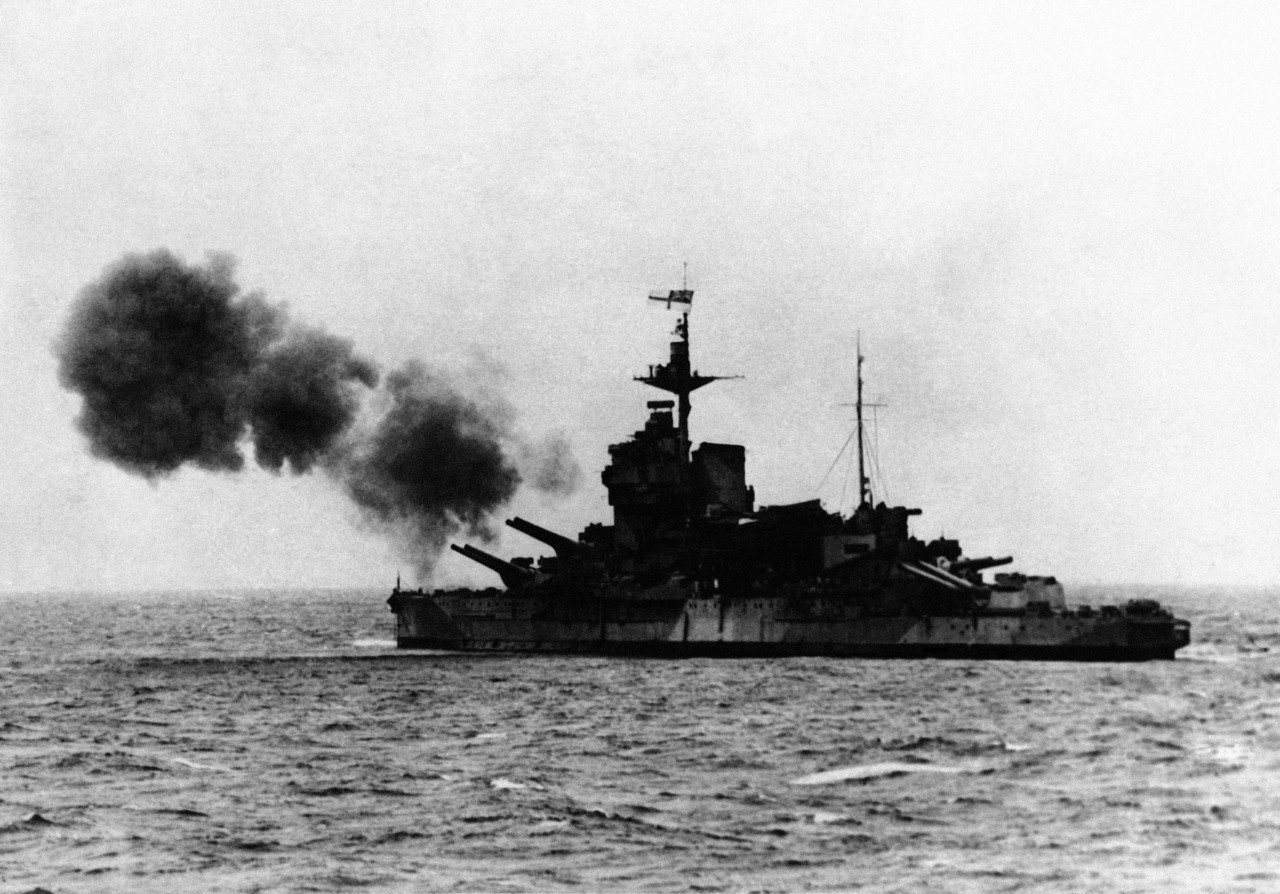

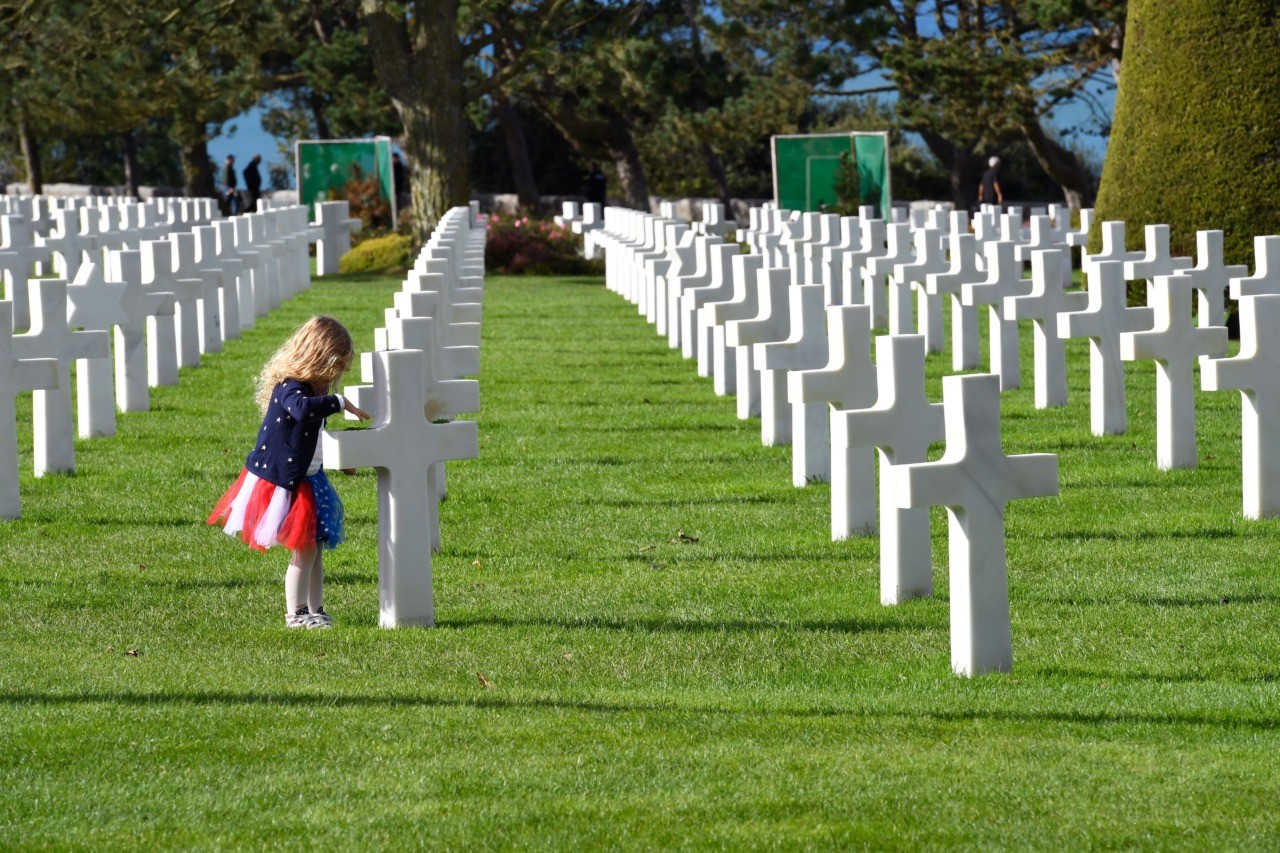
COMMENTS
Please let us know if you're having issues with commenting.